Friends of the Arboretum Newsletter
Spring 2008 – Volume 12, Number 1
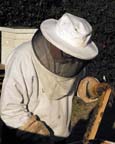 |
 |
 |
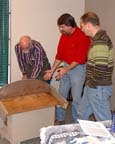 |
Words from the Director
Director's Letter
Greetings from the JC Raulston Arboretum. I am composing this piece several weeks after the wonderful rainfall that graced many parts of North Carolina in late October and again in December. The Arboretum received over 5" of rain over a three-day period in October and a few more inches in December. Although we are still in the grips of a very serious drought, and much more rain is needed, this rainfall should carry our plants through dormancy, and hopefully 2008 will not present the weather challenges that we all faced in 2007. Here's hoping that the current drought conditions will force our complacent society to address the serious issues regarding water use and misuse, and promote conservation measures and practices that are employed at all times. Unfortunately, history shows that when normal rainfall resumes, conservation initiatives quickly become forgotten. I am concerned that in times of drought and water shortages, government is too quick to target water use in gardens as the first mechanism to reduce consumption, while not addressing the root causes of water shortages such as unrestrained growth, unregulated watering of turf, and lack of year-round conservation measures at the individual and commercial level. Yes, gardeners should and will take measures to be part of the solution. However, the pursuit of gardening, one of man's oldest and most fundamental pursuits, enhances the quality of life of all who engage in it. I'm afraid that government officials who place emphasis only on allocating water to sustain economic interests are not at all considering the role of gardening as a quality-of-life pursuit. Gardeners, rise up and be counted, and make your voice heard that water for gardening purposes is just as important as water for economic interests.
Last summer and fall's drought was tough on the collections at the JCRA. We have limited staff and irrigation infrastructure to adequately water all of the collections on a timely basis, so we resorted to the use of moveable sprinklers, spot watering, Gator Bags, and lots of dedicated assistance from volunteers. Thanks to our garden staff, summer interns, and our wonderful volunteers who so faithfully came in to assist our staff to water our collections. Unfortunately, the JCRA is totally dependent on the City of Raleigh for its water, and it is critical that other water source alternatives be pursued, such as wells and reuse water. We want to do our part to reduce our impact on the municipal water supply, and to have other water alternatives during times of drought.
I am pleased to share that the JC Raulston Arboretum's Endowment for Excellence fund has now passed the $100,000.00 level. This endowment fund generates yearly income that can be used for any worthy purpose at the JCRA. One of the most serious challenges the JCRA faces is the lack of recurring yearly revenue from endowment funding. Many botanical gardens and arboreta benefit from significant yearly endowment fund revenue to sustain operations, but we do not have that luxury at the JCRA. One of my goals as director is to build our endowment funding to ensure a more dependable cash flow for the JCRA in the future. As a consequence of your generous contributions, we have made significant progress in the past two years growing the endowment fund. Continuing the tradition initiated by previous director Bob Lyons, I routinely invest $10,000.00 to $15,000.00 of yearly Gala income into the general endowment fund. If you are considering a gift to the JCRA in the near future, please consider making a contribution to the JCRA Endowment for Excellence. By doing so, you can take satisfaction that your contribution will generate recurring yearly income to sustain the operations of the JCRA.
I hope you had an opportunity to participate in some of the recent JCRA educational programs. Our recent Friends of the Arboretum Lectures have been well attended, and remember, if you miss a lecture, view it online through our members only link. Mark Weathington, our new assistant director and curator of collections, has resumed our historically popular Plantsmen's Tours on the first or second Tuesday afternoon of the month. These, too, are recorded and made available online for member viewing.
In the garden, plants in the renovated rooftop gardens and the newly installed summer Geophyte Border grew well last year. Geophytes include true bulbs and other plants with specialized underground structures such as corms, rhizomes, and tubers. The Geophyte Border was installed to demonstrate the remarkable biological diversity and ornamental beauty in this plant group, and to demonstrate the ability of geophytes to perform well even in times of drought stress. Little did we know that such a wonderful opportunity to demonstrate the drought tolerance of geophytes would present itself last summer. The Geophyte Border contains many rain-lily cultivars and species, and as one might predict, the rain-lilies had little to get excited about. However, a 2" rain event in late September that followed months of virtually no significant rainfall resulted in a rain-lily celebration (those rain-lilies can really party!) and flowering explosion, with over 30 different taxa in full flower just three days after the rain event. Events like these reaffirm the joy of gardening! Speaking of celebrations, we are celebrating the slow but steady assault and removal of most of the English ivy, Hedera sp., from the JCRA. Eradication efforts last past spring resulted in significant progress, and efforts will continue next spring. Over the years, English ivy has become pervasive in some areas of the JCRA, visually impacting display of our collections, and competing with desirable plants. We have commenced renovation of the beds in and around the Southwestern Garden, and hope to have renovation and planting completed by next spring. The garden will still house many southwestern U.S. taxa, but we will broaden the scope of the new garden to include a diversity of drought tolerant herbaceous and woody taxa, including a collection of cold-hardy palms.
The JCRA has made significant efforts to partner and develop synergistic relationships with other organizations in order to better fulfill and broaden our educational and outreach mission. We had the pleasure of partnering with the Triangle Chapter of the North Carolina Association of Landscape Architects (NCASLA) by offering a series of quarterly lunch hour seminars and JCRA tours. In late November, the North Carolina Nursery and Landscape Association (NCNLA) had their 2007 NCNLA Excellence in the Landscape Awards program at the JCRA. Historically, this awards program has been held at the association's Green and Growin' winter trade show, but NCNLA partnered with the JCRA in 2007 in order to reach a broader audience. We are pleased to be a partner.
Although the JCRA has a healthy population of wild bumblebees (Bumbus sp.) working in our collections, I have noted the general absence of honeybee activity (Apis mellifera) since my arrival. As many of you are aware, wild honeybee populations are few, and managed hives have been negatively impacted by a number of pests and stresses, including mites, beetles, and pesticides. Thanks to the generosity and interest of Charles Heatherly, president of the North Carolina Beekeepers Association, three healthy hives of honeybees were placed at the JCRA in late October. Already, one can see significant numbers of honeybees working in the JCRA collections. If I were a honeybee, I couldn't think of any better place to be. Something's in flower every day of the year. Charles tells me that the bees in these hives are derived from the Minnesota Hygienic stock that was developed by Marla Spivak, Ph.D., at the University of Minnesota a few years ago. Her main objective was to develop a mite resistant bee that would enable beekeepers to keep their colonies alive with a minimum use of miticides. In addition, Minnesota Hygienic stock bees are known for their docile behavior.
In late October, the JCRA had the pleasure of partnering with Horticulture in presenting a symposium entitled "Smaller Garden/Big Ideas." About 180 registrants were entertained and educated by five incredible speakers who shared their ideas for creating wonderful gardens in limited space. We plan to partner with Horticulture in offering future symposia. Looking ahead later this year, please "save the date" for the JCRA fall 2008 symposium on September 26-28. The 2008 symposium, entitled "Surround Yourself with Shady Characters" (the title courtesy of the fertile imagination of Tony Avent) will focus on trees for urban landscapes, gardening in a woodland environment, and biogeography of trees. We again have an exciting line-up of speakers (listed later in the newsletter). Please plan on joining other shady characters and attend our fall symposium.
 Bobby Ward, Ph.D., represented the JCRA at the Southeastern
Flower Show in Atlanta on January 29, where he accepted the Robert McGee
Balentine Horticulture Award that was awarded posthumously to J.
C. Raulston. The award is given annually to the individual who
has made the greatest contribution to the field of horticulture in the
southeastern United States. This was the first time the award was granted
posthumously. Previous recipients include Dick Bir, Alan
Armitage, Don Shadow, Ozzie Johnson,
and Ron Determan.
Bobby Ward, Ph.D., represented the JCRA at the Southeastern
Flower Show in Atlanta on January 29, where he accepted the Robert McGee
Balentine Horticulture Award that was awarded posthumously to J.
C. Raulston. The award is given annually to the individual who
has made the greatest contribution to the field of horticulture in the
southeastern United States. This was the first time the award was granted
posthumously. Previous recipients include Dick Bir, Alan
Armitage, Don Shadow, Ozzie Johnson,
and Ron Determan.
As always, thank you for your support, and please visit your JC Raulston Arboretum.
![]()
Denny Werner, Director
Horticulture
Name that Plant – The Misuse of Trademarks in Horticulture
By Tony Avent, Plant Delights Nursery
When is a plant name not a plant name? The sad answer is more often than not in our current world, where marketing comes first and accuracy second. The current plant naming trend often violates the International Code of Nomenclature for Cultivated Plants, U.S. trademark law, and occasionally the Federal Trade Commission (FTC) rules concerning deceptive business practices.
To understand the problem, let's go back in time to 1952, when the first International Code of Nomenclature for Cultivated Plants (hence referred to as the Code) was published to standardize the confusing way in which plant cultivars were named. The Code sets forth the way people around the world communicate about plants, and as long as everyone abides by the Code, problems in horticultural communication are minimal. Unfortunately, nowadays more and more people are undermining the Code, due in part to both ignorance and greed, creating a taxonomic nightmare.
The current trend of improper use of cultivar names and trademarks, both by growers and marketers of plants, has done an irreparable long-term disservice to the industry and the public by hopelessly confusing the naming of plants and the communication about these plants. Even in the latest edition of Michael Dirr's wonderful Manual of Woody Landscape Plants (5th ed.), it is clearly evident that even someone as knowledgeable as Michael Dirr, Ph.D., doesn't always know which is a cultivar name and which is simply a company's marketing name.
The Nomenclature Code
To understand where the confusion lies, let's start with a few basics about plant taxonomy. The naming of cultivated plants is governed by a small book, the International Code of Nomenclature for Cultivated Plants (7th ed., 2004). In the Preamble to the Code, the purpose is stated: "The Code aims at the provision of a stable method of naming distinguishable groups of cultivated plants, avoiding and rejecting the use of names that may cause error or ambiguity or throw the above disciplines into confusion." While the Code is not a legal document, such International Codes are usually recognized as legally valid in most court disputes.
In Principle 3, the Code states, "Each cultivar or group with a particular circumscription can bear only one accepted name, the earliest that is in accordance with the Rules." Principle 4 of the Code brings up another important point, "Names of plants must be universally and freely available for use by any person to denote a distinguishable group of plants. In some countries, plants are marketed using trademarks. Such marks are the intellectual property of a person or some corporate body and are not therefore freely available for any person to use; consequently, they cannot be considered as names."
Article 19 of the Code further deals with cultivar names. The most pertinent section is Article 19.13, which states, "For a cultivar name to be established on or after 1 January 1959, its epithet is to be a word or words in a modern language other than Latin, except as permitted under Article 19.6, 19.7, and Article 19.24." There are many other requirements, but these are not pertinent for discussion of the trademark issue. Now that we understand the basis for naming plants, let's look at how the improper use of trademarks has made a mockery of the spirit of the Code.
Trademarks
Trademark names are intended to be used only to designate product origin or brands. Trademarking can be as simple as writing ™ after a name, but for a more sound legal footing, the trademark is registered with the United States Patent and Trademark Office (USPTO). The trademark then becomes a registered trademark (®) for a cost of about $250.00 (unless you have it done by a lawyer). Trademarks are owned by an individual or company and cannot be affixed to an individual item. They are valid for 10 years if used correctly in commerce, and can be renewed indefinitely for 10-year periods.
A classic example of a properly used trademark is Tylenol®. If you look through a drug store, you will find the company had registered Tylenol® as a trademark. The product that you purchase, however, is not Tylenol®, but instead one of many products, such as Tylenol® Cold and Sinus Medicine or Tylenol® Pain Relievers. In most of these products, the generic name is acetaminophen. If a company's trademark name becomes recognized by the public as the product itself (i.e., generic), the trademark becomes invalid. Several commonly known examples of trademarks being invalidated because they have become generic in the minds of the consumer include aspirin, cellophane, thermos, and escalator. Many other incorrectly used trademarks are still in effect, simply because they have not been challenged.
The current improper use of trademarks in the horticultural industry had its origin more than a half century ago. The worst culprits, in the early years, were the rose and bedding plant industries. The rose industry seems to have been the first to use nonsensical, non-conforming names for plant cultivars, while the bedding plant industry completely thumbed its nose at the Code by not even bothering to come up with any cultivar names for most of their introductions. One of the most famous roses in horticulture is one that everyone knows as Peace. Surprisingly, there is no such plant as Rosa 'Peace'. The plant we grow under this name is actually Rosa 'Madame A. Meilland'. The trade name Peace was coined by Conard Pyle Nursery, and used to market Rosa 'Madame A. Meilland' after World War II to capitalize on the post-war sentiment. The plant became known in the public's mind as the Peace rose.
Some of the larger nurseries soon realized that regardless of the cultivar name of the plant, they could come up with their own proprietary (trademarked) marketing name and use these names to promote plants which already had valid cultivar names. The idea was to convince the public that the company's marketing name was actually the name of the plant. The next step in the downward spiral was when nurserymen began intentionally giving their new plants stupid nonsensical cultivar names. Subsequent plant promotions would often only tout the marketing name, causing the consumer to be ignorant of the fact that the plant had a real cultivar name. The cultivar name, if included at all in ads and tags, would be printed in very small print in comparison to the "marketing name." The entire idea is for the company's marketing (trademark) name to become the generic name of the product in the consumer's mind. The practice of using nonsensical names violates the entire purpose for having an International Code of Nomenclature for Cultivated Plants, while the use of trademarks as generic names violates the legal use of trademarks.
Some breeders blindly follow such trends in choosing nonsensical cultivar names, not realizing that these names are the only official name of their new introduction. A U.K. primrose breeder, Geoff Nicolle, wanted to name and patent his new primrose after his granddaughter Katy McSparron. Instead, he patented it under the cultivar name Primula 'Prinic' (PP12892) and marketed it under his granddaughter's name. I have corresponded with his granddaughter, who is furious and stubbornly insistent that the plant is named after her. Unfortunately, it is becoming quite common where people who are to be honored or commemorated by a plant being named after them are left with nothing but an invalid trademark with no plant attached. A great new plant is then stuck with a nonsensical name.
As I mentioned earlier, Article 19.13 of the Code does not allow for the use of these nonsensical names. In contradicting itself, however, the current version of the Code now allows nonsensical code name exceptions (Article 19.27). This is where political pressures have crept into what should have remained a scientific document. Privately, one of the authors of the Code told me the breeders of certain worldwide crops such as alstroemeria, carnations, and roses would raise too much of a fuss if the nomenclature committee made the wording in the Code any stronger. In other words, the authors of the current edition of the Code caved to those who were already violating the Code, similar to the concept of changing laws so that the number of criminals diminishes.
Many breeders and growers of new plants properly choose to try and recoup their investment in producing a new plant by securing a royalty payment from those producing the plant. Plant patents are the only legal means of protecting a proprietary plant. Patents are good for 20 years (formerly 17 years) from the date of patent filing. After this time, anyone can legally propagate and sell a formerly patented cultivar. Patents require quite a bit of paperwork and a fee that many smaller growers may find a bit expensive. Many growers have the false impression that trademarks give them an easier and cheaper alternative to patents, but this is not the case.
To further complicate matters, some plants are both patented and subsequently marketed under a company's trademarked name. Some nurserymen think they can get the 20-year protection the plant patent provides, plus a further measure of protection by trademarking a second (marketing) name for each plant. Once the patent expires, others could propagate a formerly patented plant, but in theory could not sell it under the company's trademark name. A classic example is Monrovia's Limemound® spirea. At the end of its patent protection in 2003, everyone could propagate Spirea 'Monhub' (PP05834), but Monrovia assumed no one else could then legally sell the plant as Limemound® spirea. Unfortunately, both nurseries and many trademark lawyers who advise nurseries seem not to understand basic trademark law.
Trademark law states that a trademark name can be used with (not for) any product produced by the owner of the trademark. For example, if the owner of the trademark was growing four different gold spireas or 100 different trees, they could all be marketed under the same trademark name, despite being distinct cultivars. Trademark names belong only to a company, and not to a particular plant or product. In other words, a single cultivar named Limemound spirea does not exist.
Article 12.1 of the Code cites Rosa 'Korlanum', which is marketed under three different trademark names, each owned by a different company, Surrey, Sommerwind, and Vente D'ete. This causes the public to assume that there are three different roses, when they are all the same plant. In the case of Loropetalum chinense f. rubrum 'Hines Purple Leaf', it is marketed under at least two different trademark names, Plum Delight and Pizzaz. This practice is becoming more common as the lack of understanding about proper trademark use deteriorates. Are you confused yet?
The issue becomes more confusing the more you investigate. Do you remember the Cornus florida × kousa hybrid dogwoods from Elwin Orton's breeding program at Rutgers? They were patented with the cultivar names of C. 'Stellar Pink' (PP07207), C. 'Galaxy' (PP07204), C. 'Aurora' (PP07205), C. 'Constellation' (PP07210), C. 'Rutfan' (PP07206), and C. 'Rutlan' (PP07732). As you can see, all of the dogwoods except two were given sensical (word or words in a modern language) cultivar names. Interestingly enough, once the dogwoods hit the market, the original sensical cultivar names were changed by the breeder to nonsensical names and the original sensical cultivar names were then trademarked. For example, Cornus 'Stellar Pink' became 'Rutgan' (Stellar Pink®); 'Galaxy' became 'Rutban' (Galaxy®); 'Aurora' became 'Rutdan' (Aurora®); 'Constellation' became 'Rutcan' (Constellation®); 'Rutlan' was marketed as (Ruth Ellen®); and 'Rutfan' was marketed as (Stardust®). This violates the Code; section 19.13 as cited above and #9 of the Preamble, which states, "The only proper reason for changing the name of a distinguishable group of plants are either a more profound knowledge of the facts resulting from adequate taxonomic study or the necessity of giving up a name that is contrary to the Rules of a Code." Therefore, the correct names for each of these hybrids were the original cultivar names under which they were patented. The reason for the name switching is so that once the patent expires, anyone can sell the dogwoods under the nonsensical names, while in theory, they cannot use the breeder's trademark name. By trying to make sure everyone knows the plants generically by his trade name, the breeder has, however, unintentionally rendered his trademark invalid.
If you visit the United States Patent and Trademark Office (USPTO) Web site, http://www.uspto.gov, you will see the Patent Office itself has no understanding of either U.S. trademark law or the Code. A classic example of this confusion occurs in the patented plant, Itea virginica 'Sprich' (PP10988). Despite the fact the cultivar name of "Sprich" is not a "word or words in a modern language" (Article 19.13) and therefore violates the spirit of the Code, it has become the legal cultivar name once it was indicated as such in the patent application. If you read the patent application for I. virginica 'Sprich', it states, "The new Itea virginica cultivar is being marketed under the trade name Little Henry®." Because a trademark cannot be permanently affixed to a particular item, it shows the USPTO doesn't even understand its own regulations.
This use of trademarks as secondary "pseudo-cultivar" names for particular plants violates both the spirit of the Code, as well as U.S. trademark law. Trademark law clearly states if a trademark name becomes the common use (generic) name of a particular item, then the trademark becomes invalidated. Trademark lawyers have long advised nurseries to write the cultivar name in single quotes and smaller type and then the trademark name without single quotes in larger type. In their minds, this keeps their trademark valid. Nurseries are also told by their trademark lawyers that as long as they enforce their trademarks, by making sure the cultivar name is always included with the trademark name, their trademarks would remain valid. This bizarre thinking, however, defeats the entire reason for improperly using trademarks, which is to trick the public into thinking the trademark name is the generic name of the product. It is this intentional deceit that will one day bring the Federal Trade Commission onto the horticultural scene.
A properly used trademark would be one such as Star® Roses, which is used to market a large group of roses under a single umbrella trademark. This trademark would have remained valid if they had not begun using their trademark to also market individual cultivars such as Rosa 'Wezaprt' as Bronze Star™ rose and Rosa 'Wezlavn' as Silver Star® rose.
Court Cases
Until 2006, one of the few cases that might have gone to trial was when Iverson Perennials tried to enforce a legal trademark they owned for the name Scabiosa 'Butterfly Blue'. The unpatented plant had been previously published with 'Butterfly Blue' as the cultivar name, so they were wrong in both trying to trademark a cultivar name and also by using their trademark improperly on a single product. Fortunately, a number of nurseries banded together against Iverson Perennials and the trademark infringement case was abandoned before it reached court.
Finally, in 2006, a case of improperly used trademarks actually reached the courts in Van Well Nursery, Inc. et al. v. Mony Life Ins. (decided March 16, 2006). In this complicated case, MONY Life Insurance Co. acquired property from A/B Hop Farms due to a defaulted loan. The property contained apple trees known as Smoothee® and Scarlet Spur®. When MONY tried to sell the land by mentioning that it contained Smoothee® and Scarlet Spur® apple trees, Van Well Nursery and Hilltop Nurseries sued for trademark infringement. Their contention was that the apples trees were actually the cultivars 'Snipes' and 'Gibson', although they had marketed them under the trademark names Smoothee® and Scarlet Spur®. The Lanham Trademark Act, section 15, says it is not the actual misuse of the trademark for a single product that makes it invalid, but, instead, the perception of the public that the trademark name is the product itself that renders the trademark invalid.
The judge in the Van Well case correctly ruled that in the public domain, the apples were known as Smoothee® and Scarlet Spur®, and therefore the legally registered trademarks were now invalid, because they had become know as the product instead of the source of the product. (The Smoothee® trademark was actually not immediately cancelled, only because the owner was not a party in this particular lawsuit.) The Scarlet Spur® trademark was cancelled despite the fact that the trademark owners had followed legal advice and always included the registered trademark symbol along with the correct cultivar names when advertising the apples. The case hinged on the age-old adage in determining the validity of a trademark: a trademark must tell "who you are" and not "what you are."
This case has huge implications for those in the nursery industry who have improperly used trademarks to market individual plants for the last several decades. The case illustrates that despite best faith efforts on the part of the trademark owners to keep their trademark names valid, it is impossible once the public views the trademark name as generic. Not only will the industry be left with shameful nonsensical cultivar names that will exist as long as the plants are grown, but nurseryman who have spent large sums of money on trademarks and trademark attorney fees and then used the trademarks in violation of U.S. trademark law will be left feeling the financial sting with no way to recoup their losses. Once the Federal Trade Commission wakes up and is urged to act as they were recently with the discrepancy of advertised and delivered pot sizes, those who market individual plants under trade names will have another fight on their hands.
It would be nice if nurseries, who indeed are ethical, but misinformed, would take the lead in reversing this terrible trend. It would also be a nice change if groups such as the Perennial Plant Association (PPA) and the American Nursery and Landscape Association (ANLA) would take a strong position on the long-term effects of dual plant naming through trademarks, which are detrimental both to the industry and the consuming public. The best way to end this trend is for reputable nurseries to take a public stand against this confusing practice for the long-term good of horticulture. Short of this, it is going to be up to the Garden Writers Association (GWA) and the American Public Gardens Association (APGA) to identify plants by their one and only cultivar name, and hopefully at the same time embarrass those who persist in making up stupid nonsensical names for good plants and illegally using trademarks to deceive the public.
References
Beck & Tysver. Lanham (Trademark) Act (15 U.S.C.) Index (BitLaw).
http://www.bitlaw.com/source/15usc/.
Duffett, B.S., Jr. ed. 1997. Patents and trademarks on plants.
Washington, DC: National Association of Plant Patent Owners.
Dirr, M. A. 1998. Manual of woody landscape plants: Their identification,
ornamental characteristics, culture, propagation, and uses. 5th ed.
Champaign, IL: Stipes Publishing.
Goria, V. 1996. Making your mark. American Nurseryman.
Plant Patent Directory. 1997. Washington, DC: American Nursery and
Landscape Association.
Trehane, P., C.D. Brickell, B.R. Baum, W.L.A. Hetterscheid, A.C. Leslie,
J. McNeill, S.A. Spongberg, and F. Vrugtman, eds. 1995. International
code of nomenclature for cultivated plants. Wimborne, UK: Quarterjack
Publishing.
United States Patent and Trademark Office. http://www.uspto.gov.
Van Well Nursery, Inc. et al. v. Mony Life Ins., No. 04-0245 (E. D.
Wash. March 16, 2006).
The JCRA strives to ensure correct labeling for the permanent collections. Permanent labels in the JCRA are engraved with the plant's correct scientific name, its common name, family, and geographic origin. While trademark names are not part of the scientific name, and are often used improperly in violation of the International Code of Nomenclature for Cultivated Plants, we do include them as part of the plant's common name. For example Lagerstroemia indica 'Witt II' has the common trademark name Dynamite® crepe myrtle on our labels. Although we strongly disagree with the common trend to assign a trademark name to an individual plant, we provide this name to ensure that visitors looking for a trademarked plant seen at the JCRA will be able to find it at their local garden center.
Hardy Palms
By Mark Weathington, Assistant Director and Curator of Collections
Palms bring to mind images of the South Seas, lazy ocean breezes wafting over white dunes, and tall tropical drinks served with a fruit garnish. These prehistoric plants are not restricted to tropical isles though, growing everywhere from the equator to Europe, the southeastern United States, and southern Australia. In fact, the only places palms are generally absent are very cold or very dry locales.
The hardy palms from warm temperate areas make excellent additions to the landscape with their dramatic forms and bold textures. Many are hardy in Zone 8, but with proper placement several will grow throughout Zone 7 without resorting to extreme measures. Once established and mature, palms are often much hardier than generally given credit. Planting near a wall or similar warm microclimate will greatly increase survivability.
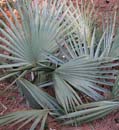 Perhaps the most widely grown group of palms in the southeast is the Sabal palms.
The dwarf palmetto (Sabal minor) is the most northerly member
in this genus. It ranges from North Carolina down the coast and around
the Gulf of Mexico to Oklahoma and Mexico. The fan shaped, blue-green
foliage arises from an underground trunk. Dwarf palmetto flowers when
young and produces masses of black bead-like fruit which is ornamental
but can be a nuisance over walkways. It makes a very good garden plant,
looking equally at home in a tropical garden, perennial border, or massed
as a tall ground cover or hedge. The state tree of South Carolina, Sabal
palmetto also creeps into southern North Carolina, but is not as hardy
as its dwarf cousin. This tree form of palmetto is quick-growing with
a stout trunk. In cooler areas, it certainly needs some protection when
young. The dead foliage can be left on maturing plants as a natural insulation.
A hypothesized hybrid named 'Birmingham' with a shorter, stouter trunk
than S. palmetto has been a longtime favorite among hardy palm
enthusiasts, surviving regularly in Zone 7 once established.
Perhaps the most widely grown group of palms in the southeast is the Sabal palms.
The dwarf palmetto (Sabal minor) is the most northerly member
in this genus. It ranges from North Carolina down the coast and around
the Gulf of Mexico to Oklahoma and Mexico. The fan shaped, blue-green
foliage arises from an underground trunk. Dwarf palmetto flowers when
young and produces masses of black bead-like fruit which is ornamental
but can be a nuisance over walkways. It makes a very good garden plant,
looking equally at home in a tropical garden, perennial border, or massed
as a tall ground cover or hedge. The state tree of South Carolina, Sabal
palmetto also creeps into southern North Carolina, but is not as hardy
as its dwarf cousin. This tree form of palmetto is quick-growing with
a stout trunk. In cooler areas, it certainly needs some protection when
young. The dead foliage can be left on maturing plants as a natural insulation.
A hypothesized hybrid named 'Birmingham' with a shorter, stouter trunk
than S. palmetto has been a longtime favorite among hardy palm
enthusiasts, surviving regularly in Zone 7 once established.
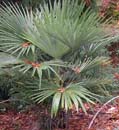 The hardiest of the tree type palms, Trachycarpus fortunei,
or windmill palm, from China, grows naturally in cold mountainous areas.
It has survived throughout the warmer areas of Zone 7 when mature. The
fan shaped foliage topping the relatively thin trunk is very distinctive
as is the burlap-like fiber which persists on the trunk. Although some
gardeners prefer to "clean-up" this palm by stripping off the fiber and
removing the skirt of dead leaves, these features may help improve the
plant's resistance to quick drops in temperature. Several hardier forms
are in the trade such as Taylor Form and Bulgarian Strain. Other species
of Trachycarpus are available to the enthusiast, such as T.
takil, a hardy Himalayan palm closely related to the typical windmill
palm.
The hardiest of the tree type palms, Trachycarpus fortunei,
or windmill palm, from China, grows naturally in cold mountainous areas.
It has survived throughout the warmer areas of Zone 7 when mature. The
fan shaped foliage topping the relatively thin trunk is very distinctive
as is the burlap-like fiber which persists on the trunk. Although some
gardeners prefer to "clean-up" this palm by stripping off the fiber and
removing the skirt of dead leaves, these features may help improve the
plant's resistance to quick drops in temperature. Several hardier forms
are in the trade such as Taylor Form and Bulgarian Strain. Other species
of Trachycarpus are available to the enthusiast, such as T.
takil, a hardy Himalayan palm closely related to the typical windmill
palm.
 The needle palm, Rhapidophyllum hystrix, carries long spines
on the short, stout trunk. Large palm-shaped leaves on long petioles make
a bold statement on this slow-growing woodland palm. Its native range
is from South Carolina to Mississippi. It is perhaps the hardiest of all
the temperate palms, surviving below 0°F easily, once established. One
of the largest specimens in North Carolina can be found in the Arboretum
near the Winter Garden.
The needle palm, Rhapidophyllum hystrix, carries long spines
on the short, stout trunk. Large palm-shaped leaves on long petioles make
a bold statement on this slow-growing woodland palm. Its native range
is from South Carolina to Mississippi. It is perhaps the hardiest of all
the temperate palms, surviving below 0°F easily, once established. One
of the largest specimens in North Carolina can be found in the Arboretum
near the Winter Garden.
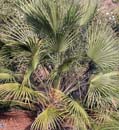 There are many other palms being trialed by palm enthusiasts throughout
the temperate zone. Others that should be tried by the adventurous gardener
include Butia capitata, B. yatay, Chamaerops humilis (a very hardy
European palm), Brahea armata, and some of the Livistona species.
There are many other palms being trialed by palm enthusiasts throughout
the temperate zone. Others that should be tried by the adventurous gardener
include Butia capitata, B. yatay, Chamaerops humilis (a very hardy
European palm), Brahea armata, and some of the Livistona species.
Growing hardy palms is generally easy. Palms tolerate a wide range of soil types, but will perform better in a well-drained soil. Heavy clay should be thoroughly amended with organic matter to aid in drainage before planting palms. Even the hardiest palms will often benefit from protection from freezes when young. Protecting the crown of a young plant with pinestraw or some other insulator before extreme weather will help smaller plants survive, but the insulation should be removed to prevent excess moisture from building up and rotting the growing point. The extra insulation can be left in place for the winter, but should be checked occasionally to make sure excess moisture is not building up at the palm's growing point. If this is a problem, remove the pinestraw, allow the palm to dry, and replace the protection when temperatures drop again. Most temperate palms will grow in full sun even as young plants, but will also tolerate partial shade. Palms respond well to fertilizer when young and yearly applications of compost will greatly aid the growth and appearance of palms. Being relatively shallow rooted, palms will also benefit from mulching to regulate summer soil temperatures and retain water.
Banana Tree?
By Tim Alderton, Research Technician
I frequently hear people saying "That's a banana tree?!" when first spotting the Musa basjoo at the end of the Perennial Border. Then, after I tell them that it spends the entire winter outside unprotected, I typically hear a surprised, "I didn't think banana trees would grow here!" After hearing them say "banana tree" a second time, I have to set them straight on the misconception that bananas grow on trees like many other fruits. Actually, bananas are giant herbaceous plants like their distant cousins, cannas and gingers. They have no woody trunk as you would have on a tree; what looks like a "trunk" is actually just tightly clasping sheaths. The stem of the plant is the rhizome that is at or just below the surface of the soil.
Now that I am over with my "bananas don't grow on trees" rant, I guess I should tell you a bit more about the plants. Bananas are in the family Musaceae which is made up of three genera: Musa, which is the largest genus with about 50 species; Ensete, currently with 6-8 species, depending on which taxonomist one asks; and Musella, one or two species, again depending on which taxonomist and maybe even the day of the week one asks. Tropical Africa, Australia, and Asia are where bananas are native, but they have been transported throughout the world.
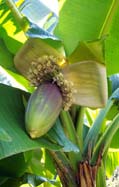 Musa species are native to southeastern Asia and northeastern
Australia, generally growing in rainforest habitats. Despite their tropical
affinity, some species have proven to be rather hardy in the southeastern
United States, though with the loss of some or all of their top growth
during the winter. Often, the hardier species originate from higher elevations
of 5,000'-10,000' and, as a result, may experience infrequent freezes and
sometimes snow. The most frequently seen of these hardy Musa species
is M. basjoo, the Japanese fiber banana. Considered the hardiest,
it is believed to have originated in the Sichuan region of China and has
since been distributed over much of southeastern Asia, including southern
Japan. Musa basjoo can grow from 10'-20' if not cut down by extreme
cold weather. It will often flower after a few years, but if it is frozen
back or cut back to the ground, it will generally grow 8'-10' in one season,
but not flower. A rare variegated form is a challenge to find.
Musa species are native to southeastern Asia and northeastern
Australia, generally growing in rainforest habitats. Despite their tropical
affinity, some species have proven to be rather hardy in the southeastern
United States, though with the loss of some or all of their top growth
during the winter. Often, the hardier species originate from higher elevations
of 5,000'-10,000' and, as a result, may experience infrequent freezes and
sometimes snow. The most frequently seen of these hardy Musa species
is M. basjoo, the Japanese fiber banana. Considered the hardiest,
it is believed to have originated in the Sichuan region of China and has
since been distributed over much of southeastern Asia, including southern
Japan. Musa basjoo can grow from 10'-20' if not cut down by extreme
cold weather. It will often flower after a few years, but if it is frozen
back or cut back to the ground, it will generally grow 8'-10' in one season,
but not flower. A rare variegated form is a challenge to find.
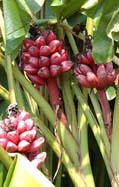 Another species that has proven hardy in the Raleigh area is Musa
velutina, the pink velvet banana. Musa velutina hails
from Assam in northeastern India. It is a much smaller growing species,
topping out at about 8'. M. velutina reliably flowers and fruits
each year, despite dying back to the ground. The pink bracts that surround
the yellow flowers and the resulting crop of velvety pink fruit are what
give this species its common name. The pulp of the fruit is edible and
tastes like that of typical banana, but the fruit is made up of about
10% pulp and 90% rock-hard seed with which you could pave a street (maybe
a good diet food as you would spend more energy separating seed from
pulp than you would get from eating it). This species is easily grown
from seed and will often have volunteer seedlings underneath it.
Another species that has proven hardy in the Raleigh area is Musa
velutina, the pink velvet banana. Musa velutina hails
from Assam in northeastern India. It is a much smaller growing species,
topping out at about 8'. M. velutina reliably flowers and fruits
each year, despite dying back to the ground. The pink bracts that surround
the yellow flowers and the resulting crop of velvety pink fruit are what
give this species its common name. The pulp of the fruit is edible and
tastes like that of typical banana, but the fruit is made up of about
10% pulp and 90% rock-hard seed with which you could pave a street (maybe
a good diet food as you would spend more energy separating seed from
pulp than you would get from eating it). This species is easily grown
from seed and will often have volunteer seedlings underneath it.
 Of the Musa species, M. basjoo and M. velutina are
the most common and widely available, but there are some other species
that may prove hardy. These have only been on the market for a few years
and may be worth searching out. The one that I have tried personally is Musa
sikkimensis, the Darjeeling banana. This species is native to northeastern
India and Bhutan in forests up to 6,000' and in some areas experiences
frost and snow. It has proven hardy, but generally dies to the ground
if unprotected. Musa sikkimensis is often grown from seed. Different
forms are becoming available. Some with red streaking in the leaf blade
as well as forms that have a red midrib can be found. Another that Tony
Avent has been growing in his garden for a few years is Musa
itinerans, the Yunnan banana. This species is native to the Yunnan
Province of China and has been known to grow at elevations of up to 9,000'.
It is noted for its tall, slender form and more rapid growth than other
bananas.
Of the Musa species, M. basjoo and M. velutina are
the most common and widely available, but there are some other species
that may prove hardy. These have only been on the market for a few years
and may be worth searching out. The one that I have tried personally is Musa
sikkimensis, the Darjeeling banana. This species is native to northeastern
India and Bhutan in forests up to 6,000' and in some areas experiences
frost and snow. It has proven hardy, but generally dies to the ground
if unprotected. Musa sikkimensis is often grown from seed. Different
forms are becoming available. Some with red streaking in the leaf blade
as well as forms that have a red midrib can be found. Another that Tony
Avent has been growing in his garden for a few years is Musa
itinerans, the Yunnan banana. This species is native to the Yunnan
Province of China and has been known to grow at elevations of up to 9,000'.
It is noted for its tall, slender form and more rapid growth than other
bananas.
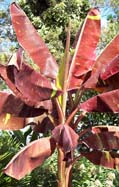
 With protection, many other less hardy Musa species
and cultivars can be grown in this area. For years, Tony has grown the less
hardy forms by building a large cage around the clump in order to protect
the psuedotrunks and filling the cage with leaves for insulation. This has
allowed him to have fruit on Musa 'Orinoco', a fruiting cultivar, for many
years. One of the new cultivars that has become available is Musa 'Siam
Ruby', a wonderful red-leafed banana with flecks of yellowy green that
will stand out in any landscape. Who cares if it flowers? It only grows
to about 6'-8'. Musa 'Bordelon' should be grown for the foliage
(streaked with red) and the pink inflorescence (if protected over winter)
to provide interest in the garden. For those who have no ground, there
are small cultivars that can be kept in pots. Musa 'High Colored
Mini' tops out at a whopping 36"-48" and can be fruited indoors. The leaves
on M. 'High Colored Mini' have irregular red splotching. Another
"giant," Musa 'Little Prince', grows only about knee high at 2'-2.5'.
It does not flower or fruit, but has diminutive size that anyone can squeeze
into the smallest planting or container.
With protection, many other less hardy Musa species
and cultivars can be grown in this area. For years, Tony has grown the less
hardy forms by building a large cage around the clump in order to protect
the psuedotrunks and filling the cage with leaves for insulation. This has
allowed him to have fruit on Musa 'Orinoco', a fruiting cultivar, for many
years. One of the new cultivars that has become available is Musa 'Siam
Ruby', a wonderful red-leafed banana with flecks of yellowy green that
will stand out in any landscape. Who cares if it flowers? It only grows
to about 6'-8'. Musa 'Bordelon' should be grown for the foliage
(streaked with red) and the pink inflorescence (if protected over winter)
to provide interest in the garden. For those who have no ground, there
are small cultivars that can be kept in pots. Musa 'High Colored
Mini' tops out at a whopping 36"-48" and can be fruited indoors. The leaves
on M. 'High Colored Mini' have irregular red splotching. Another
"giant," Musa 'Little Prince', grows only about knee high at 2'-2.5'.
It does not flower or fruit, but has diminutive size that anyone can squeeze
into the smallest planting or container.
Ensete has a much larger native distribution than that of Musa or Musella. There are species found in both Africa and southeastern Asia, generally growing in grassy and rocky areas. There are many differences among the banana genera, but Ensete is most easily distinguished from Musa and Musella by the fact that they do not typically sucker and are monocarpic (die after they flower). They are generally not as cold or wet tolerant as Musa and Musella, often rotting during the winter months when grown outdoors.
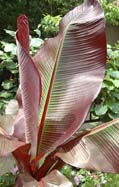 The species that one is most likely to encounter is Ensete ventricosum,
the Abyssinian banana. It is native throughout much of tropical Africa.
Over this wide range, there is lots of variation. Variability occurs in
the leaf color and the midrib color as well as floral morphology and seed
size. The typical species can be grown rather easily from seed and can
attain a rather large size quickly. I grew one at home in Pennsylvania.
When planted out the second year, it grew to over 8' tall and 12' across,
with individual leaves measuring 6' long. In the garden centers, you are
most likely to find a red-leafed form called Ensete ventricosum 'Maurellii'.
It is propagated typically from tissue culture today, but, in the past,
was forced to make suckers by removing the apical meristem (shoot growth
point) from the crown of the plant, forcing it to make adventitious shoots.
These would then be divided.
The species that one is most likely to encounter is Ensete ventricosum,
the Abyssinian banana. It is native throughout much of tropical Africa.
Over this wide range, there is lots of variation. Variability occurs in
the leaf color and the midrib color as well as floral morphology and seed
size. The typical species can be grown rather easily from seed and can
attain a rather large size quickly. I grew one at home in Pennsylvania.
When planted out the second year, it grew to over 8' tall and 12' across,
with individual leaves measuring 6' long. In the garden centers, you are
most likely to find a red-leafed form called Ensete ventricosum 'Maurellii'.
It is propagated typically from tissue culture today, but, in the past,
was forced to make suckers by removing the apical meristem (shoot growth
point) from the crown of the plant, forcing it to make adventitious shoots.
These would then be divided.
A few less common species from Asia are becoming more available by seed. The widely distributed Ensete glaucum, the snow banana, ranges from India east to Papua New Guinea. This species is rather homogenous in appearance over its range, but is found from the lowland tropics up to 6,000'-8,000' in elevation, making a possible variation in hardiness. The plant has a blue-glaucus caste to the leaves, hence the name, and pseudostem. A second species now available is Ensete superbum, cliff banana, found in parts of India. This species, as its name indicates, often grows on rocky slopes. Unlike many other bananas, this one goes dormant during the dry season, dying back to a corm-like base, and then resprouts when water is available. Sounds like it might take our weather! All three of these Ensete typically top out at about 10'-12' in this area due to the fact that when they are left in the ground they die back. They might grow taller but for the fact that one can not handle moving or storing anything larger if they are dug and moved inside.
 The third genus in the Musaceae is Musella. Musella has
only been recognized as a genus since the late 1970s. Up until that point,
it was bounced back and forth between Musa and Ensete.
This was because Musella has characteristics that fit both. Currently,
the only accepted species is Musella lasiocarpa, the Chinese yellow
banana. This species was collected and described by the botanist Abbé
Delavay in 1885 in Yunnan, China, but did not become popular in
the west until about 10 years ago. Musella is compact by banana
standards, only reaching 4'-6' tall. The foliage is a glaucus blue-green
and is not prone to tearing in the wind like most bananas. The most notable
characteristic is the large, bright yellow inflorescence that lasts for
months. Lotus-like is how many have described the shape of the inflorescence,
resulting in another common name, the "golden lotus banana." Another noteworthy
attribute is its hardiness. It is reported to grow at elevations of up
to 8,200', making it hardy to at least Zone 7, and some reports even say
Zone 5.
The third genus in the Musaceae is Musella. Musella has
only been recognized as a genus since the late 1970s. Up until that point,
it was bounced back and forth between Musa and Ensete.
This was because Musella has characteristics that fit both. Currently,
the only accepted species is Musella lasiocarpa, the Chinese yellow
banana. This species was collected and described by the botanist Abbé
Delavay in 1885 in Yunnan, China, but did not become popular in
the west until about 10 years ago. Musella is compact by banana
standards, only reaching 4'-6' tall. The foliage is a glaucus blue-green
and is not prone to tearing in the wind like most bananas. The most notable
characteristic is the large, bright yellow inflorescence that lasts for
months. Lotus-like is how many have described the shape of the inflorescence,
resulting in another common name, the "golden lotus banana." Another noteworthy
attribute is its hardiness. It is reported to grow at elevations of up
to 8,200', making it hardy to at least Zone 7, and some reports even say
Zone 5.
This has just been a taste of the bananas that you might find to try. Do a search online! You'll find that there are many more bananas that may be of interest. Often, they can be quickly and cheaply grown form seed. A little more can be spent to purchase divisions that will rapidly grow into large plants to grace your garden. Their leaves and sometimes their flowers give a tropical look to almost any yard and break up that boring corner in your landscape, not to mention making your neighbors ask, "Is that a banana tree?"
Tough Plants for Tough Times
By Denny Werner, Ph.D., Director
The year 2007 will certainly go down in history as one of the more trying years for gardeners. A relatively mild winter and early spring was followed by a severe freeze on Easter weekend, after most woody plants had already flushed and produced significant amounts of new growth. This Easter freeze was only the first volley of gardening challenges delivered by Mother Nature, as the dry conditions of spring evolved into serious drought and record heat in summer and fall. In spite of the trying conditions, one can always look upon the past year as an opportunity to learn more about the plants we grow at the Arboretum and in our gardens, and use that information to help us choose plants that not only tolerate, but perform admirably in tough times. I learned much this past summer, and have acquired a new-found respect for the remarkable resiliency of plants and their ability to withstand and survive stress. Accordingly, this article is devoted to coverage of selected plants that performed well in year 2007, some "tough plants for tough times."
This was an excellent year to assess the performance of annual bedding plants during times of stress. The All-America Selections trial gardens were planted in early May, and because of subsequent water restrictions, we ceased watering the trials in late July. Hence, all entries were truly on their own for the remainder of the growing season. A more detailed article describing the performance of the trials follows in this newsletter, but a few star performers will be highlighted here. Our petunia trials had 72 entries in 2007, and in those trials, Petunia 'USTUNI6001' (Supertunia® Vista Bubblegum) stole the show, producing a continuous succession of small, deep pink flowers from early summer through mid-October. Like many of the newer petunias, Bubblegum Vista produces relatively small flowers as compared to the multiflora and grandiflora cultivars of earlier years. What it and many of the new hybrids lack in flower size is compensated for by the sheer number of flowers and extended flowering interval. Other star performers were Petunia 'Sunsurfpinkai' (Surfinia® Baby Pink Ice) and 'Keiwhihus' (Surfinia® Mini Mini White).
I admire the small-flowered, compact zinnias, and the Profusion® series of zinnias (Zinnia elegans) performed admirably. This compact series works well as an edging or border plant, and, like their taller brethren, never fail to attract lots of butterflies. Another beautiful, small-flowered zinnia that thrived in the heat and drought was Zinnia maritima 'Solcito', displaying yellow flowers with a brown center.
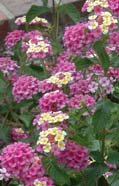 Our lantana (Lantana sp.) trials commanded much attention this
year, as lantana are some of the most heat- and drought-tolerant bedding
plants available. Perennial woody subshrubs in their tropical native habitat,
lantanas are typically grown as annuals here in Zone 7b, although many
cultivars have overwintered in recent years during our mild winters. However,
as a confirmation of just how hot and dry it was this summer, even the
lantanas were wilting as the season progressed. All of our cultivars performed
well, but my personal favorite was Lantana camara 'Pinata', sporting
a hot combination of red and orange flowers in profusion all summer long.
For those who prefer a cultivar more likely to overwinter and perennialize,
consider the newly available 'Ham and Eggs'. Many visitors have admired
this cultivar at the JCRA, where it resides near the Visitor Center. The
inflorescence contains many deep pink flowers (ham) encircling a center
of bright yellow flowers (eggs). On very early morning excursions into
the garden, shortly after dawn, I noted that the inflorescences were entirely
pink, and the eggs didn't start "sizzling" until some newly formed flowers
emerged yellow in the center of the inflorescence a few hours after dawn.
These yellow flowers eventually turned pink with age. An added positive
attribute of 'Ham and Eggs' is its low fruit set, a distinct advantage,
as lantana fruit are toxic.
Our lantana (Lantana sp.) trials commanded much attention this
year, as lantana are some of the most heat- and drought-tolerant bedding
plants available. Perennial woody subshrubs in their tropical native habitat,
lantanas are typically grown as annuals here in Zone 7b, although many
cultivars have overwintered in recent years during our mild winters. However,
as a confirmation of just how hot and dry it was this summer, even the
lantanas were wilting as the season progressed. All of our cultivars performed
well, but my personal favorite was Lantana camara 'Pinata', sporting
a hot combination of red and orange flowers in profusion all summer long.
For those who prefer a cultivar more likely to overwinter and perennialize,
consider the newly available 'Ham and Eggs'. Many visitors have admired
this cultivar at the JCRA, where it resides near the Visitor Center. The
inflorescence contains many deep pink flowers (ham) encircling a center
of bright yellow flowers (eggs). On very early morning excursions into
the garden, shortly after dawn, I noted that the inflorescences were entirely
pink, and the eggs didn't start "sizzling" until some newly formed flowers
emerged yellow in the center of the inflorescence a few hours after dawn.
These yellow flowers eventually turned pink with age. An added positive
attribute of 'Ham and Eggs' is its low fruit set, a distinct advantage,
as lantana fruit are toxic.
For those of you that admire the character and delicacy of baby's breath (Gypsophila sp.), but accept that it is difficult to grow and has a short flowering interval, consider Euphorbia 'Inneuphdia' (Diamond Frost®). This is the second year Diamond Frost® has been in our bedding plant trials, and it definitely lives up to its billing. Forming a mound about 1'-1.5' in height, with similar spread, Diamond Frost® is covered with hundreds of small, white flowers all season long. Never once did it show any signs of drought or heat stress, and the flowers just kept coming and coming. Many gardeners are now choosing to use Diamond Frost® as a container plant, for after establishment, it can perform well in a container without the need for regular watering. I know container gardening is the current craze, and I am impressed with the beautiful containers I see in residential and commercial landscapes. Personally, I shy away from containers, as I prefer not to be held hostage to the need for daily watering of container gardens, but Diamond Frost®, and other drought-tolerant plants, free one from the daily watering commitment.
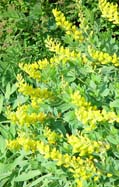 In the herbaceous perennial realm, the expanding array of available Baptisia cultivars
provides the gardener with great choices in this wonderful genus of typically
spring-flowering, drought-tolerant North American natives. Their thick
fleshy roots and extensive rhizomes allow them to survive even the most
serious drought conditions. Members of the legume family, these plants
are capable of "fixing" atmospheric nitrogen, and hence can grow well even
in nutrient poor soils. Whereas just a few years ago only the common species
were available in the trade, all propagated by seed, recent progress in
various breeding programs and advances in asexual propagation, including
micro propagation, have expanded the choices immensely. Two hybrids selected
and introduced by the North Carolina Botanical Garden are excellent choices
for your first foray into Baptisia. 'Purple Smoke', a hybrid
of B. minor var. aberrans and B. alba,
produces beautiful dusty purple flowers, while 'Carolina Moonlight', a
hybrid of B. sphaerocarpa and B. alba, produces
beautiful spikes of soft yellow flowers. If bright yellow flower color
is your preference, choose the straight species, B. sphaerocarpa,
and in particular, the cultivar 'Screamin' Yellow'. Baptisia alba 'Wayne's
World', a recent discovery by Tony Avent from seed collected
in Wayne County, North Carolina, is a more vigorous and upright form of B. alba,
growing to 5', and makes a bold statement in the garden. Baptisia form
interesting and quite ornamental seedpods, and if you wish to enjoy and
appreciate these in your garden, choose the straight species, as many of
the hybrids produce a reduced number of seedpods. Many other wonderful
choices exist in this great group, and you can't go wrong with any of them.
In the herbaceous perennial realm, the expanding array of available Baptisia cultivars
provides the gardener with great choices in this wonderful genus of typically
spring-flowering, drought-tolerant North American natives. Their thick
fleshy roots and extensive rhizomes allow them to survive even the most
serious drought conditions. Members of the legume family, these plants
are capable of "fixing" atmospheric nitrogen, and hence can grow well even
in nutrient poor soils. Whereas just a few years ago only the common species
were available in the trade, all propagated by seed, recent progress in
various breeding programs and advances in asexual propagation, including
micro propagation, have expanded the choices immensely. Two hybrids selected
and introduced by the North Carolina Botanical Garden are excellent choices
for your first foray into Baptisia. 'Purple Smoke', a hybrid
of B. minor var. aberrans and B. alba,
produces beautiful dusty purple flowers, while 'Carolina Moonlight', a
hybrid of B. sphaerocarpa and B. alba, produces
beautiful spikes of soft yellow flowers. If bright yellow flower color
is your preference, choose the straight species, B. sphaerocarpa,
and in particular, the cultivar 'Screamin' Yellow'. Baptisia alba 'Wayne's
World', a recent discovery by Tony Avent from seed collected
in Wayne County, North Carolina, is a more vigorous and upright form of B. alba,
growing to 5', and makes a bold statement in the garden. Baptisia form
interesting and quite ornamental seedpods, and if you wish to enjoy and
appreciate these in your garden, choose the straight species, as many of
the hybrids produce a reduced number of seedpods. Many other wonderful
choices exist in this great group, and you can't go wrong with any of them.
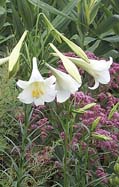 Summer bulbs as a group perform very well during times of drought stress.
Bulbs and other geophytes (plants with specialized underground storage
organs such as corms and tubers) store water in these below-ground structures,
allowing them to withstand periods of reduced water availability. Our
new summer Geophyte Border was established this past spring, and in spite
of the drought, performed admirably with little supplemental irrigation.
I invite you to come look at this border during the 2008 growing season
to get summer and fall geophyte ideas for your garden. I always promote
crinum lilies (Crinum sp.) in my presentations, as I think they
provide so many attributes in the garden, in addition to drought tolerance.
First and foremost, being a member of the Amaryllis family, species of Crinum produce
natural compounds called alkaloids that confer resistance to deer grazing
and vole damage. Crinum lilies are rugged and long lived, relatively maintenance
free once established, and provide so much satisfaction for so little investment.
Refer to the fall 2007 Friends of the JC Raulston Arboretum Newsletter for
specific cultivar recommendations. Another great heat- and drought-tolerant
bulbous species that commands lots of attention in the summer border is Lilium
formosanum, the Formosan lily. Formosan lily is closely related to
the common Easter lily, and produces Easter lily-like flowers on the terminals
of tall stems rising 6'-7' in height. It makes an incredible display in
early August, and in my home landscape, never fails to attract the attention
of garden visitors. After flowering, resist the urge to deadhead, as the
attractive seed pods make great additions to dried flower arrangements.
Summer bulbs as a group perform very well during times of drought stress.
Bulbs and other geophytes (plants with specialized underground storage
organs such as corms and tubers) store water in these below-ground structures,
allowing them to withstand periods of reduced water availability. Our
new summer Geophyte Border was established this past spring, and in spite
of the drought, performed admirably with little supplemental irrigation.
I invite you to come look at this border during the 2008 growing season
to get summer and fall geophyte ideas for your garden. I always promote
crinum lilies (Crinum sp.) in my presentations, as I think they
provide so many attributes in the garden, in addition to drought tolerance.
First and foremost, being a member of the Amaryllis family, species of Crinum produce
natural compounds called alkaloids that confer resistance to deer grazing
and vole damage. Crinum lilies are rugged and long lived, relatively maintenance
free once established, and provide so much satisfaction for so little investment.
Refer to the fall 2007 Friends of the JC Raulston Arboretum Newsletter for
specific cultivar recommendations. Another great heat- and drought-tolerant
bulbous species that commands lots of attention in the summer border is Lilium
formosanum, the Formosan lily. Formosan lily is closely related to
the common Easter lily, and produces Easter lily-like flowers on the terminals
of tall stems rising 6'-7' in height. It makes an incredible display in
early August, and in my home landscape, never fails to attract the attention
of garden visitors. After flowering, resist the urge to deadhead, as the
attractive seed pods make great additions to dried flower arrangements.
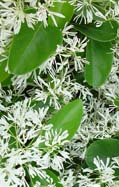 While visiting Japan in spring 2007, I had the pleasure of seeing Chionanthus
retusus (Asian fringe tree) in the wild in mixed stands with Styrax
japonicus (Japanese silver bells). Both were in full flower at
the time of my visit. It was such a treat to observe these species in
their native habitat after observing them for years in various garden
settings. Although the Easter weekend freeze destroyed the flower buds
and ruined the subsequent flower display on the Chionanthus retusus at
the Arboretum, this species was one of the star performers during the
summer drought. Its thick, leathery leaves are resistant to moisture
loss, and little evidence of drought stress was observed during the entire
growing season. Chionanthus retusus forms a rounded, large
shrub to a small tree, and the slightly fragrant, delicate flowers grace
the spring garden. During your next visit to the JCRA, examine the new
cultivar of C. retusus added to our collections. Named 'Ivory
Tower', this cultivar shows a distinct upright growth habit. You will
find it near where the old Brick House used to stand. Although rarely
promoted, the fall color on C. retusus, and its native relative, C.
virginicus, often develops into an attractive yellow.
While visiting Japan in spring 2007, I had the pleasure of seeing Chionanthus
retusus (Asian fringe tree) in the wild in mixed stands with Styrax
japonicus (Japanese silver bells). Both were in full flower at
the time of my visit. It was such a treat to observe these species in
their native habitat after observing them for years in various garden
settings. Although the Easter weekend freeze destroyed the flower buds
and ruined the subsequent flower display on the Chionanthus retusus at
the Arboretum, this species was one of the star performers during the
summer drought. Its thick, leathery leaves are resistant to moisture
loss, and little evidence of drought stress was observed during the entire
growing season. Chionanthus retusus forms a rounded, large
shrub to a small tree, and the slightly fragrant, delicate flowers grace
the spring garden. During your next visit to the JCRA, examine the new
cultivar of C. retusus added to our collections. Named 'Ivory
Tower', this cultivar shows a distinct upright growth habit. You will
find it near where the old Brick House used to stand. Although rarely
promoted, the fall color on C. retusus, and its native relative, C.
virginicus, often develops into an attractive yellow.
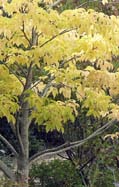 Situated in the Mixed Border, the summer-flowering Tetradium baberi (Baber's
bee-bee tree) has much to offer the gardener besides its tolerance to drought.
This member of the citrus family (Rutaceae) forms an attractive small to
medium tree, with clusters of white summer flowers and attractive yellow
fall color. Like Cyrilla racemiflora, another great drought tolerant
plant I have discussed in prior newsletter writings, T. baberi attracts
an amazing diversity of insect species, including bees, wasps, butterflies,
beetles, and others. In full flower, the frenzy of insect activity is
incredible. Crush the leaves or young stems and enjoy the distinct citrus-like
fragrance.
Situated in the Mixed Border, the summer-flowering Tetradium baberi (Baber's
bee-bee tree) has much to offer the gardener besides its tolerance to drought.
This member of the citrus family (Rutaceae) forms an attractive small to
medium tree, with clusters of white summer flowers and attractive yellow
fall color. Like Cyrilla racemiflora, another great drought tolerant
plant I have discussed in prior newsletter writings, T. baberi attracts
an amazing diversity of insect species, including bees, wasps, butterflies,
beetles, and others. In full flower, the frenzy of insect activity is
incredible. Crush the leaves or young stems and enjoy the distinct citrus-like
fragrance.
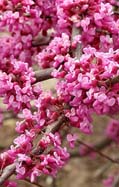 As a group, members of the genus Cercis are highly tolerant of
drought conditions. The Texas redbud (Cercis canadensis subsp. texensis)
probably represents the best in drought tolerance of the North American
types. Texas redbud is generally more compact than typical eastern redbud,
and produces thick, attractive, glossy leaves that are resistant to moisture
loss. My first cultivar choice in this group is 'Oklahoma', displaying
deep purple flower color. The late J. C. Raulston ranked
'Oklahoma' as his favorite deciduous tree. My observations of plantings
of 'Oklahoma' in various commercial landscape settings this past summer
confirmed its drought resistance. If you prefer a weeping form of Texas
redbud, choose 'Traveller', named by its developer in honor of Robert
E. Lee's horse. This attractive weeping cultivar has a graceful
architecture that, in my opinion, is superior to that of 'Covey', the more
common weeping cultivar available in the trade. Interestingly, 'Traveller'
is also sterile, and produces no viable pollen or seedpods, an asset for
those who dislike the tendency of redbud to self-sow in the landscape.
I have carefully studied 'Traveller' for over 15 years, and have never
seen a seedpod form on it. If any of you ever observe a seedpod on a tree
of 'Traveller', please call me collect!
As a group, members of the genus Cercis are highly tolerant of
drought conditions. The Texas redbud (Cercis canadensis subsp. texensis)
probably represents the best in drought tolerance of the North American
types. Texas redbud is generally more compact than typical eastern redbud,
and produces thick, attractive, glossy leaves that are resistant to moisture
loss. My first cultivar choice in this group is 'Oklahoma', displaying
deep purple flower color. The late J. C. Raulston ranked
'Oklahoma' as his favorite deciduous tree. My observations of plantings
of 'Oklahoma' in various commercial landscape settings this past summer
confirmed its drought resistance. If you prefer a weeping form of Texas
redbud, choose 'Traveller', named by its developer in honor of Robert
E. Lee's horse. This attractive weeping cultivar has a graceful
architecture that, in my opinion, is superior to that of 'Covey', the more
common weeping cultivar available in the trade. Interestingly, 'Traveller'
is also sterile, and produces no viable pollen or seedpods, an asset for
those who dislike the tendency of redbud to self-sow in the landscape.
I have carefully studied 'Traveller' for over 15 years, and have never
seen a seedpod form on it. If any of you ever observe a seedpod on a tree
of 'Traveller', please call me collect!
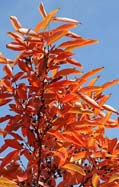 For unrivaled fall color, it is difficult to exceed the beauty of the
genus Lindera, represented by both North American and Asian species.
Many species in this group generally form medium to large shrubs and produce
a brilliant fall color display. One can justify their inclusion in the
garden based on this character alone. Two species in the Arboretum were
particularly noteworthy for their drought tolerance this past summer: Lindera
angustifolia, in the Winter Garden, and L. salicifolia, in
the east Arboretum bed that is adjacent to and parallels Beryl Road. In
addition to their attractive, orange-red, autumn leaf color, both species
form attractive black berries that stand out on the brilliantly colored
foliage background.
For unrivaled fall color, it is difficult to exceed the beauty of the
genus Lindera, represented by both North American and Asian species.
Many species in this group generally form medium to large shrubs and produce
a brilliant fall color display. One can justify their inclusion in the
garden based on this character alone. Two species in the Arboretum were
particularly noteworthy for their drought tolerance this past summer: Lindera
angustifolia, in the Winter Garden, and L. salicifolia, in
the east Arboretum bed that is adjacent to and parallels Beryl Road. In
addition to their attractive, orange-red, autumn leaf color, both species
form attractive black berries that stand out on the brilliantly colored
foliage background.
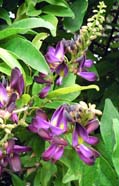 For those interested in a drought tolerant vine, consider the summer flowering Millettia
taiwaniana, commonly incorrectly named in gardens (including the
JCRA in the past!) as Millettia taiwanensis. Look for this
great vine in the east Arboretum. Commonly called summer wisteria, M. taiwaniana is
an evergreen to semi-evergreen relative of true wisteria. It will slowly
grow up a support 12'-15' high or can be left to grow as a sprawling
shrub 4'-6' tall by 10' wide. In colder areas, it may be killed to the
ground, but will re-sprout in mid to late spring. Beautiful reddish-purple
flowers are carried in masses of stiff, branched spikes in late summer
(July-August). The foliage is deep, glossy green and leathery enough
to deter most insects. The evergreen foliage carried on stout woody
stems is spectacular growing on pergolas and along fences, while its
restrained growth rate makes it a much lower maintenance vine than some
of its more vigorous relatives.
For those interested in a drought tolerant vine, consider the summer flowering Millettia
taiwaniana, commonly incorrectly named in gardens (including the
JCRA in the past!) as Millettia taiwanensis. Look for this
great vine in the east Arboretum. Commonly called summer wisteria, M. taiwaniana is
an evergreen to semi-evergreen relative of true wisteria. It will slowly
grow up a support 12'-15' high or can be left to grow as a sprawling
shrub 4'-6' tall by 10' wide. In colder areas, it may be killed to the
ground, but will re-sprout in mid to late spring. Beautiful reddish-purple
flowers are carried in masses of stiff, branched spikes in late summer
(July-August). The foliage is deep, glossy green and leathery enough
to deter most insects. The evergreen foliage carried on stout woody
stems is spectacular growing on pergolas and along fences, while its
restrained growth rate makes it a much lower maintenance vine than some
of its more vigorous relatives.
In addition to the species described above, I include below a list of other plants that performed well during the drought and heat of 2007.
| Acca sellowiana 'NCSU Hardy' | pineapple guava | |
| Acer buergerianum 'Mino Yatsubusa' | dwarf trident maple | |
| Arbutus unedo 'Elfin King' | compact strawberry tree | |
| Betula nigra 'Summer Cascade' | weeping river birch | |
| Buxus spp. | boxwood | |
| Cornus mas | cornelian cherry | |
| Croton alabamensis | Alabama croton | |
| Euonymus carnosus | fleshy flowered spindletree | |
| Ilex vomitoria | yaupon holly | |
| Litsea japonica | Japanese litsea | |
| Nyssa sylvatica | black gum | |
| Osmanthus fragrans | sweet olive | |
| Osmanthus heterophyllus | holly tea-olive | |
| Picea pungens 'Hoopsii' | Colorado blue spruce | |
| Pinus densiflora 'Oculis-draconis' | dragon's eye Japanese red pine | |
| Pistachia chinensis | Chinese pistache | |
| Podocarpus macrophyllus var. maki | Japanese yew pine | |
| Quercus polymorpha | Monterrey oak | |
| Rhapidophyllum hystrix | needle palm | |
| Rhus typhina 'Bailtiger' | gold staghorn sumac | |
| Salix 'Flame' | red-stem willow | |
| Ulmus alata 'Lace Parasol' | weeping winged elm | |
| Viburnum obovatum | Walter's viburnum |
Acknowledgements: Thanks to Mark Weathington, Tim Alderton, and Anthony Beck for their suggestions and assistance with this article.
Leaves of Interest
By Cheryl Kearns, Volunteer
In a discussion about the merits of a plant, a number of gardeners single out such features as the flower, fruit, or bark of a plant, but not often does one hear about the leaves, other than in talking about texture. It would be a shame, then, to miss such an engaging feature as the unusual shapes and tactile aspects of certain leaves seen in the JCRA's collection.
 For example, consider the wonderfully different – some would even say
funky – leaves of Gingko biloba 'Tubeleaf' or Morus alba 'Ho-O'.
The names alone suggest these two plants deserve a closer look. The gingko
tree, one of the oldest trees on Earth, is known as being reliably hardy
and for its beautiful golden fall foliage; but the leaf shape is very distinctive,
often celebrated in jewelry and other art forms. The leaves of the cultivar
'Tubeleaf' take on an origami-like element on their own, with small, slender
leaves appearing as tubes and curling inwards and upwards. These artistic
tubes are most pronounced on vigorous, young shoots, while the tree itself
grows slowly to a vase form about 40' tall. Unraveling the leaves, as
a child of any age has to do, reveals long-fingered lobes with the central
one being much more pointed than the fan shape of the species. (Wearing
gloves as a precaution might be a good idea if you handle gingko; any part
of the tree can cause a rash or allergic reaction.) Once established,
this small tree is quite drought tolerant; in fact, doing poorly with too
much watering. Like the species, 'Tubeleaf' thrives in full sun and produces
striking yellow fall color.
For example, consider the wonderfully different – some would even say
funky – leaves of Gingko biloba 'Tubeleaf' or Morus alba 'Ho-O'.
The names alone suggest these two plants deserve a closer look. The gingko
tree, one of the oldest trees on Earth, is known as being reliably hardy
and for its beautiful golden fall foliage; but the leaf shape is very distinctive,
often celebrated in jewelry and other art forms. The leaves of the cultivar
'Tubeleaf' take on an origami-like element on their own, with small, slender
leaves appearing as tubes and curling inwards and upwards. These artistic
tubes are most pronounced on vigorous, young shoots, while the tree itself
grows slowly to a vase form about 40' tall. Unraveling the leaves, as
a child of any age has to do, reveals long-fingered lobes with the central
one being much more pointed than the fan shape of the species. (Wearing
gloves as a precaution might be a good idea if you handle gingko; any part
of the tree can cause a rash or allergic reaction.) Once established,
this small tree is quite drought tolerant; in fact, doing poorly with too
much watering. Like the species, 'Tubeleaf' thrives in full sun and produces
striking yellow fall color.
 The category of funky leaves would also have to include those of the royal
white mulberry (Morus alba 'Ho-O'). This is a truly textural
leaf, in the best sense of texture, positively demanding to be touched.
The main surface of the leaf is roughly crinkled and distorted, as though
too much material were forced between the lines of veins. This rippled
effect is reminiscent of peaks and valleys all squished together. Just
Fruits and Exotics' on-line catalog describes the leaves as looking "like
a living topographic map" – a very apt simile. 'Ho-O' is Japanese for
king or royalty, and such a rare plant certainly would be king in the garden.
It will grow in most soils to 23'-30' in sun to part shade, producing yellow
fall foliage but no fruit.
The category of funky leaves would also have to include those of the royal
white mulberry (Morus alba 'Ho-O'). This is a truly textural
leaf, in the best sense of texture, positively demanding to be touched.
The main surface of the leaf is roughly crinkled and distorted, as though
too much material were forced between the lines of veins. This rippled
effect is reminiscent of peaks and valleys all squished together. Just
Fruits and Exotics' on-line catalog describes the leaves as looking "like
a living topographic map" – a very apt simile. 'Ho-O' is Japanese for
king or royalty, and such a rare plant certainly would be king in the garden.
It will grow in most soils to 23'-30' in sun to part shade, producing yellow
fall foliage but no fruit.
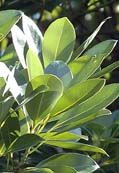 Persea thurnbergii (formerly Machilus thunbergii) also
demands to be touched due to its rich leathery texture. The leaves are
also appealing because they are different sizes and sometimes found marching
up the branch in alternate fashion or in groupings on a branch tip, reminiscent
of pittosporum. Add in the fact that the new leaves are bronze and turn
to a shiny olive green and you have a possible replacement for the beloved
but ill-fated redtips (Photinia). In its native China and Japan,
it grows as an understory tree to 80' tall, but here it will take full
sun to light shade and needs a protected spot, and only tops out at about
15', a much more manageable-sized evergreen for small gardens.
Persea thurnbergii (formerly Machilus thunbergii) also
demands to be touched due to its rich leathery texture. The leaves are
also appealing because they are different sizes and sometimes found marching
up the branch in alternate fashion or in groupings on a branch tip, reminiscent
of pittosporum. Add in the fact that the new leaves are bronze and turn
to a shiny olive green and you have a possible replacement for the beloved
but ill-fated redtips (Photinia). In its native China and Japan,
it grows as an understory tree to 80' tall, but here it will take full
sun to light shade and needs a protected spot, and only tops out at about
15', a much more manageable-sized evergreen for small gardens.
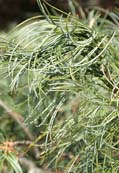 Then there is the Pinus strobus 'Torulosa', another specimen
demanding attention in the garden, gracefully twirling its bluish whorls
at the ends of and even along its branches in a "come dance with me" fashion.
This pyramidal pine gets 16' in 12 years. The overall look is one of lots
of blue-green to near-white pompoms dotted all over the tree for a year-round
festive look. This is another tree for full sun, but it needs to be kept
from wind-swept alleys as the branching is slightly brittle. With adequate
moisture to get it established, this pine becomes quite drought tolerant.
Then there is the Pinus strobus 'Torulosa', another specimen
demanding attention in the garden, gracefully twirling its bluish whorls
at the ends of and even along its branches in a "come dance with me" fashion.
This pyramidal pine gets 16' in 12 years. The overall look is one of lots
of blue-green to near-white pompoms dotted all over the tree for a year-round
festive look. This is another tree for full sun, but it needs to be kept
from wind-swept alleys as the branching is slightly brittle. With adequate
moisture to get it established, this pine becomes quite drought tolerant.
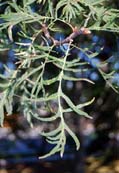 Further eye candy is found in the leaves of Quercus robur 'Pectinata',
commonly called the cut-leaf English oak. Imagine a cutleaf Japanese maple
on steroids. The leaves are vaguely recognizable as oak leaves with deeply
incised fingers, turning cinnamon to straw colors in the fall. 'Pectinata'
grows slowly into a small or medium sized tree and tolerates moist soils,
and is good for erosion control on banks.
Further eye candy is found in the leaves of Quercus robur 'Pectinata',
commonly called the cut-leaf English oak. Imagine a cutleaf Japanese maple
on steroids. The leaves are vaguely recognizable as oak leaves with deeply
incised fingers, turning cinnamon to straw colors in the fall. 'Pectinata'
grows slowly into a small or medium sized tree and tolerates moist soils,
and is good for erosion control on banks.
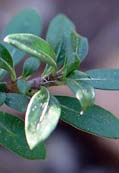 In stark contrast to the relative largesse of the 'Pectinata' oak leaf
is the delightfully diminutive leaf of Serissa foetida 'Kyoto',
a native of Japan's famously holy and ancient city. The gold rim on the
leaf, from which the shrub takes its common name, is visible without a
microscope – just. 'Kyoto' is the smallest of the yellow-rim shrubs, topping
out at a petite 1' and making it perfectly adaptable for use as a bonsai
plant. The combination of leaves and the multitudes of tiny, trumpet-shaped,
white flowers give it other, more romantic, monikers: tree of a thousand
shooting stars and snow rose. In the home garden, give it a little sun
and mostly indirect shade, and keep it well watered for its first year
or two.
In stark contrast to the relative largesse of the 'Pectinata' oak leaf
is the delightfully diminutive leaf of Serissa foetida 'Kyoto',
a native of Japan's famously holy and ancient city. The gold rim on the
leaf, from which the shrub takes its common name, is visible without a
microscope – just. 'Kyoto' is the smallest of the yellow-rim shrubs, topping
out at a petite 1' and making it perfectly adaptable for use as a bonsai
plant. The combination of leaves and the multitudes of tiny, trumpet-shaped,
white flowers give it other, more romantic, monikers: tree of a thousand
shooting stars and snow rose. In the home garden, give it a little sun
and mostly indirect shade, and keep it well watered for its first year
or two.
These artistic, funky, colorful, and otherwise appealing leaves don't have to be viewed only at the JCRA – add some leafy pizzazz to your own garden.
Jasminum parkeri – Dwarf Evergreen Jasmine
By Mark Weathington, Assistant Director and Curator of Collections
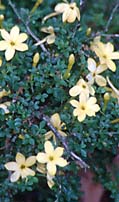 Dwarf evergreen jasmine (Jasminum parkeri) is, as its common
name implies, a very small evergreen woody shrub. The dissected foliage
is a dark green which serves as a good foil for the cheery yellow flowers
in late spring through early summer. Despite being a jasmine, the fragrance,
although sweet, is relatively faint. The shrub works well at the front
of a shrub border, in southern rock gardens, or, if massed, it makes an
effective ground cover.
Dwarf evergreen jasmine (Jasminum parkeri) is, as its common
name implies, a very small evergreen woody shrub. The dissected foliage
is a dark green which serves as a good foil for the cheery yellow flowers
in late spring through early summer. Despite being a jasmine, the fragrance,
although sweet, is relatively faint. The shrub works well at the front
of a shrub border, in southern rock gardens, or, if massed, it makes an
effective ground cover.
This jasmine is easy to care for and grows best in any sunny spot in ordinary garden soil. Do not over fertilize. Dwarf evergreen jasmine is often grown as an edging plant and in rock gardens. Pruning is generally unnecessary unless growing it as a bonsai.
Record Southeast Drought Highlights the Toughest New Bedding Plants: Top Performers in a Trying Year at the JC Raulston Arboretum Summer 2007 Bedding Plant Trials
Denny Werner, Ph.D., Director, and John Dole, Ph.D., Department of Horticultural Science, NC State University
You have to love the names – Cuphea 'Totally Tempted', Dahlia 'Knockout' (Mystic® Illusion), Plectranthus 'Cervesa N' Lime', Salvia splendens 'Dancing Flame'.... Each year, dozens of new plants are released with wonderfully enticing names. The challenge for trial gardens is to find out which plants live up to their names. This year, the JC Raulston Arboretum trialed 565 bedding plants submitted by 17 companies. And what a challenging year it was! Record heat and drought provided a true test of performance, and because of local water use restrictions, no supplemental irrigation was provided to the trials after late July. The selections ranged from the classic petunias and geraniums to funky new juncus with many fun and interesting plants in between. The following are the JC Raulston Arboretum picks for plants to consider for this upcoming year.
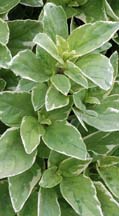 Texture is back, but this time it is stronger than ever, updated with
bold lines, bright colors, and herby fragrance. Let's start with the latter. Ocinum ×citriodorum 'Pesto
Perpetuo' has an Italian sounding name that brings to mind steaming plates
of pasta with spicy pesto or a rich spaghetti sauce. But this basil also
makes a great garden plant, reminiscent of young Italian cypress. The
sturdy compact plants are very uniform and much more vigorous, up to 2'
tall, than any of the older globe basils. 'Pesto Perpetuo' would bring
height to mixed herb containers or would work as a formal backdrop to a
flowerbed. Tall growing basils tend to be a bit rangy, but this cultivar
kept its striking shape throughout the season. The interesting gray-green
color would make it a nice foil for bright or dark colors. The culinary
aspects shouldn't be ignored as the foliage is large enough for easy harvest
and, unlike typical culinary basils, plants did not flower by the end of
the season so, they kept producing plenty of foliage.
Texture is back, but this time it is stronger than ever, updated with
bold lines, bright colors, and herby fragrance. Let's start with the latter. Ocinum ×citriodorum 'Pesto
Perpetuo' has an Italian sounding name that brings to mind steaming plates
of pasta with spicy pesto or a rich spaghetti sauce. But this basil also
makes a great garden plant, reminiscent of young Italian cypress. The
sturdy compact plants are very uniform and much more vigorous, up to 2'
tall, than any of the older globe basils. 'Pesto Perpetuo' would bring
height to mixed herb containers or would work as a formal backdrop to a
flowerbed. Tall growing basils tend to be a bit rangy, but this cultivar
kept its striking shape throughout the season. The interesting gray-green
color would make it a nice foil for bright or dark colors. The culinary
aspects shouldn't be ignored as the foliage is large enough for easy harvest
and, unlike typical culinary basils, plants did not flower by the end of
the season so, they kept producing plenty of foliage.
Continuing with the herb theme, Plectranthus 'Cervesa N' Lime' produced a rounded mound of soft, fuzzy, wonderfully fragrant leaves. Plants were exceptionally drought tolerant and grew 12" to 18" tall by the end of the season. The color is not particularly noticeable, so place plants where they can be easily touched – deliberately or accidentally – such as in a mixed container by a walkway or stairs. When fall comes, take a cutting or two to start a windowsill plant for the winter.
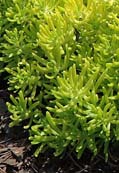 On the shorter side, we were impressed with the ground cover Sedum rupestre 'Lemon
Coral' for its soft texture that made you want to touch it or, better yet,
roll in it! The bright chartreuse color was as bright as any flower and
certainly a bonus. While many sedums are rather slow growing, this one
was fairly vigorous and uniform, making it useful for both containers and
landscape beds.
On the shorter side, we were impressed with the ground cover Sedum rupestre 'Lemon
Coral' for its soft texture that made you want to touch it or, better yet,
roll in it! The bright chartreuse color was as bright as any flower and
certainly a bonus. While many sedums are rather slow growing, this one
was fairly vigorous and uniform, making it useful for both containers and
landscape beds.
For long interesting lines, three plant groups should be mentioned. Umbrella plant (Cyperus sp.) is already well known in some areas of the country but little used here. Typically used in wet sites or in aquatic plantings, Cyperus excels in normal garden settings and is actually quite drought tolerant. Cyperus papyrus (King Tut®) was a vigorous plant that grew to 4' or 6' tall. The long straight stems were topped with large spiky "flower" clusters, like an old-fashioned feather duster. Plants filled out a bed quickly, tolerating the heat and drought with no problems. A planting of this selection would be great for landscapers or as a backdrop to a large home flowerbed. For those with less room, one plant in a large pot would be quite striking. The smaller Cyperus alternifolius 'Baby Tut' was also very durable and would be good for small gardens, but resembled its weedy nutsedge relative just a little too much for comfort.
Two cultivars of juncus, Juncus inflexus 'Blue Arrows' and J. pallidus 'Javelin', performed very well in the trials. Relatively similar, they had long straight stems to about 2' tall. As a stand-alone plant, it was not particularly noticeable, but would work well to add height to medium-sized mixed containers.
Acalyphas (Acalypha sp.), some of which are also known as copperleafs, have been cultivated for years, often as a pass-along plant. It is time these plants get rediscovered for the garden. Their large, brightly colored leaves offer bold textures for large flowerbeds and containers. In the trials this year, Acalypha wilkesiana 'Bronze Pink' stood out with bright, bold, pinkish-bronze leaves (yes, the name is quite accurate). Some cultivars such as 'Firestorm' and 'Sizzle Scissors' have a profusion of long, narrow, colorful leaves. The plants tend to be tall so use them in the back of the bed or in large containers.
Cupheas (Cuphea sp.) are another group of plants with many pass-along members. Commercial plant breeders have been giving them plenty of attention lately and producing some wonderful garden plants. One cultivar, 'Totally Tempted', has bright red petals with a purplish throat and great flower power. Older types were also floriferous but had smaller flowers, which resulted in what looked like a mostly green plant. These newer types show more color. Cupheas also tend to be drought and heat tolerant, and 'Totally Tempted' is no different.
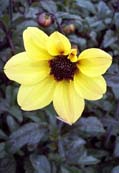 Dahlias (Dahlia sp.) have a long history in American gardens
and are so popular with home gardeners that they have their own society
of devotees. In the south, however, most dahlias tend to suffer from the
heat, putting on a large flush of flowers early in the season and again
in late summer and early fall. Unfortunately, in the middle of the season
we are left with few flowers and unsightly seed heads to remove. A number
of perennial types of dahlias are available, some with beautiful bronze
to purple foliage, but many are quite tall and lanky and lack flower power.
The Mystic® series of dahlias are trying to change that image. One cultivar
in that group, Dahlia 'Knockout' (Mystic® Illusion), has many
bright yellow, single flowers with dark centers atop a compact mound of
burgundy to black foliage. The combination is quite striking. The rate
of flowering still drops during the summer, but the beautiful foliage makes
up the difference and carries the plant through the summer. One feature
we especially like is that the seed heads are also very dark and blend
in with the foliage, making deadheading optional. Other flower colors
are available and all should be tried for flowerbeds and large containers.
Plants may be winter hardy in warmer areas or with protection.
Dahlias (Dahlia sp.) have a long history in American gardens
and are so popular with home gardeners that they have their own society
of devotees. In the south, however, most dahlias tend to suffer from the
heat, putting on a large flush of flowers early in the season and again
in late summer and early fall. Unfortunately, in the middle of the season
we are left with few flowers and unsightly seed heads to remove. A number
of perennial types of dahlias are available, some with beautiful bronze
to purple foliage, but many are quite tall and lanky and lack flower power.
The Mystic® series of dahlias are trying to change that image. One cultivar
in that group, Dahlia 'Knockout' (Mystic® Illusion), has many
bright yellow, single flowers with dark centers atop a compact mound of
burgundy to black foliage. The combination is quite striking. The rate
of flowering still drops during the summer, but the beautiful foliage makes
up the difference and carries the plant through the summer. One feature
we especially like is that the seed heads are also very dark and blend
in with the foliage, making deadheading optional. Other flower colors
are available and all should be tried for flowerbeds and large containers.
Plants may be winter hardy in warmer areas or with protection.
 Annual salvias (Salvia sp.) are often quite a bit flashier than
their perennial cousins, producing large spikes of brightly colored flowers
on short plants. Salvia splendens 'Dancing Flame' takes the flashiness
to a new extreme: bright red spikes of flowers on a brilliantly yellow
and green variegated plant. This is not a plant for pastel lovers. The
flower spikes are not as large as many of the annual cultivars, but the
bright foliage makes up for any difference. Use in locations that need
to be brightened up. It does well in beds or in containers.
Annual salvias (Salvia sp.) are often quite a bit flashier than
their perennial cousins, producing large spikes of brightly colored flowers
on short plants. Salvia splendens 'Dancing Flame' takes the flashiness
to a new extreme: bright red spikes of flowers on a brilliantly yellow
and green variegated plant. This is not a plant for pastel lovers. The
flower spikes are not as large as many of the annual cultivars, but the
bright foliage makes up for any difference. Use in locations that need
to be brightened up. It does well in beds or in containers.
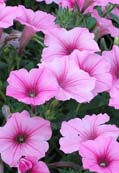 If you have not grown petunias for a while, it might be time to try them
again. Up until recently, the petunia market was dominated by cultivars
with large flowers and limited durability. They performed well in the
north but tended to look quite bedraggled fairly quickly here in the south,
often going green in the middle of the summer. Luckily, plant breeders
have been busy working on this group and listening to consumers' comments.
The breeders have incorporated fresh germplasm into hybrids that now produce
smaller flowers on plants with greater durability and vigor in the landscape.
The results were evident in the Arboretum's trials. Several cultivars
performed remarkably well in the absence of supplemental irrigation most
of the summer, including Petunia 'USTUNI6001' (Supertunia® Vista
Bubblegum), 'USTUNI8902' (Supertunia® Vista Fuchsia), 'Revolution Pastelpink
No. 3' (Surfinia® Pastel Pink), and 'Kirimaji Veiny Pink' (Suncatcher™
Pink Vein). All have small to medium-sized flowers, but produce them in
abundance. Plants are viney and tend to be moderately vigorous. One other
characteristic you might have missed if you haven't grown petunias in a
while – fragrance. Be sure to plant them where you walk at night as the
fragrance is best in the late afternoon and early evening, especially on
warm humid nights.
If you have not grown petunias for a while, it might be time to try them
again. Up until recently, the petunia market was dominated by cultivars
with large flowers and limited durability. They performed well in the
north but tended to look quite bedraggled fairly quickly here in the south,
often going green in the middle of the summer. Luckily, plant breeders
have been busy working on this group and listening to consumers' comments.
The breeders have incorporated fresh germplasm into hybrids that now produce
smaller flowers on plants with greater durability and vigor in the landscape.
The results were evident in the Arboretum's trials. Several cultivars
performed remarkably well in the absence of supplemental irrigation most
of the summer, including Petunia 'USTUNI6001' (Supertunia® Vista
Bubblegum), 'USTUNI8902' (Supertunia® Vista Fuchsia), 'Revolution Pastelpink
No. 3' (Surfinia® Pastel Pink), and 'Kirimaji Veiny Pink' (Suncatcher™
Pink Vein). All have small to medium-sized flowers, but produce them in
abundance. Plants are viney and tend to be moderately vigorous. One other
characteristic you might have missed if you haven't grown petunias in a
while – fragrance. Be sure to plant them where you walk at night as the
fragrance is best in the late afternoon and early evening, especially on
warm humid nights.
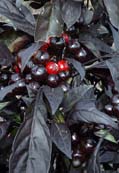 For those who like to take advantage of the impact of purple leaf color
in a landscape planting, the ornamental pepper Capsicum annuum 'Black
Pearl' is indispensable. This versatile plant shows deep purple leaf color
that holds up well throughout the entire growing season, and produces deep
purple to black, small, rounded fruit that turn a rich red as they ripen.
Highly drought tolerant, 'Black Pearl' attains a height of about 18", and
provides both foliar and fruit interest. The fruit can be harvested and
used as a seasoning, but be careful, they are HOT!
For those who like to take advantage of the impact of purple leaf color
in a landscape planting, the ornamental pepper Capsicum annuum 'Black
Pearl' is indispensable. This versatile plant shows deep purple leaf color
that holds up well throughout the entire growing season, and produces deep
purple to black, small, rounded fruit that turn a rich red as they ripen.
Highly drought tolerant, 'Black Pearl' attains a height of about 18", and
provides both foliar and fruit interest. The fruit can be harvested and
used as a seasoning, but be careful, they are HOT!
Widely promoted and used primarily as a perennial in the past, heucheras (Heuchera sp.) are now being recognized for their potential as great additions to annual beds. The incredible diversity in leaf color and variegation patterns allows one to find a heuchera for almost any landscape application. Wrongly considered by many to be adapted only to shady, moist sites, many heuchera can tolerate full sun and drought conditions, and are very versatile landscape plants. One of the top performers in our trails was Heuchera 'PWHeu0109' (Dolce® Blackcurrant), demonstrating deep purple leaves with silver accents, and a bright red-purple underside. Situated in full sun, Blackcurrant showed no signs of leaf burn. Blackcurrant can be used at the front of the bed, and would be particularly striking paired with grey or silver leaved plants to accentuate its purple leaf color. The heat and drought tolerance of heuchera suggests it should be more widely promoted and used as a container plant.
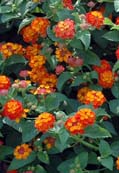 Indicative of just how hot and dry it was last summer, even the lantana
(Lantana sp.) showed some signs of drought stress! The range
of available colors in lantana seems to improve every year, and few plants
perform better under conditions of high heat and drought. One couldn't
go wrong with any of the selections in our trials this year, but many of
our guests were particularly attracted to Lantana camara 'Pinata',
with its hot combination of red and orange flowers, and 'Balandroglim'
(Landmark™ Rose Glow Improved), with its beautiful combination of pink,
magenta, and pale yellow. Lantanas are typically grown as annuals, but
if a true perennial form is what you desire (Zone 7b or higher), try the
new cultivar 'Ham and Eggs', which showed restrained growth and a great
combination of pink and pale yellow flowers. This cultivar graces a small
bed adjacent to the JC Raulston Arboretum's Visitor Center, and elicited
favorable comment from all who visit. We observed significant differences
in fruit set among the cultivars in our trials this year, and plan to document
this more thoroughly in future years. Low fruit set is an attribute, as
fruit are toxic, and lantana is potentially invasive in warmer areas of
the United States.
Indicative of just how hot and dry it was last summer, even the lantana
(Lantana sp.) showed some signs of drought stress! The range
of available colors in lantana seems to improve every year, and few plants
perform better under conditions of high heat and drought. One couldn't
go wrong with any of the selections in our trials this year, but many of
our guests were particularly attracted to Lantana camara 'Pinata',
with its hot combination of red and orange flowers, and 'Balandroglim'
(Landmark™ Rose Glow Improved), with its beautiful combination of pink,
magenta, and pale yellow. Lantanas are typically grown as annuals, but
if a true perennial form is what you desire (Zone 7b or higher), try the
new cultivar 'Ham and Eggs', which showed restrained growth and a great
combination of pink and pale yellow flowers. This cultivar graces a small
bed adjacent to the JC Raulston Arboretum's Visitor Center, and elicited
favorable comment from all who visit. We observed significant differences
in fruit set among the cultivars in our trials this year, and plan to document
this more thoroughly in future years. Low fruit set is an attribute, as
fruit are toxic, and lantana is potentially invasive in warmer areas of
the United States.
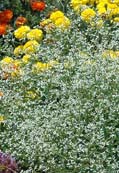 No plant in our trials took the heat and drought any better than did Euphorbia 'Inneuphdia'
(Diamond Frost®). This was the second year in the trials, and it is proving
to be a real "attention-getter." Many of our guests first ask if it is
baby's breath (Gysophila sp.), for it has that character and appearance.
That it is certainly not baby's breath is confirmed when it continues to
flower non-stop through the intense heat of the entire summer. Diamond
Frost® flowered from late spring until frost, and never showed any signs
of drought or heat stress. Growing 12" to 18" in height, with about twice
the spread, Diamond Frost® produces a continuous cloud of small, white
flowers and small, delicate light-green leaves. This is a perfect plant
for xeric landscapes. Diamond Frost® is also a great container plant,
adding an air of informality as it spills down the side of any container.
As a container plant, it has the added benefit or requiring little water,
thus freeing one from the need of frequent watering. Diamond Frost® is
now being marketed as a companion plant with poinsettia.
No plant in our trials took the heat and drought any better than did Euphorbia 'Inneuphdia'
(Diamond Frost®). This was the second year in the trials, and it is proving
to be a real "attention-getter." Many of our guests first ask if it is
baby's breath (Gysophila sp.), for it has that character and appearance.
That it is certainly not baby's breath is confirmed when it continues to
flower non-stop through the intense heat of the entire summer. Diamond
Frost® flowered from late spring until frost, and never showed any signs
of drought or heat stress. Growing 12" to 18" in height, with about twice
the spread, Diamond Frost® produces a continuous cloud of small, white
flowers and small, delicate light-green leaves. This is a perfect plant
for xeric landscapes. Diamond Frost® is also a great container plant,
adding an air of informality as it spills down the side of any container.
As a container plant, it has the added benefit or requiring little water,
thus freeing one from the need of frequent watering. Diamond Frost® is
now being marketed as a companion plant with poinsettia.
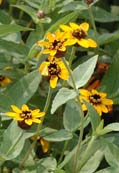 Continuing the drought and heat tolerant theme, the small-flowered Zinnia
maritima 'Solcito' was a top performer in 2007. 'Solcito' has small,
nickel-sized, yellow flowers with a dark brown cone. Like its larger
brethren, it's a favorite of butterflies and bees. Reaching about 12"
in height with similar spread, 'Solcito' produces hundreds of flowers
all season long, and is a nice intermediate form between the more narrow-leaved Zinnia
linearis types and the larger and coarser Zinnia elegans.
No mildew was observed.
Continuing the drought and heat tolerant theme, the small-flowered Zinnia
maritima 'Solcito' was a top performer in 2007. 'Solcito' has small,
nickel-sized, yellow flowers with a dark brown cone. Like its larger
brethren, it's a favorite of butterflies and bees. Reaching about 12"
in height with similar spread, 'Solcito' produces hundreds of flowers
all season long, and is a nice intermediate form between the more narrow-leaved Zinnia
linearis types and the larger and coarser Zinnia elegans.
No mildew was observed.
The number of geraniums (Pelargonium sp.) in our trials exceeds that of any other group, confirming the continued popularity of geraniums in the bedding plant trade. Geraniums often suffer in the heat and humidity of central North Carolina, and the extreme conditions of 2007 resulted in poor performance of most of our accessions. However, two selections, 'Cante Coras' (Caliente™ Coral) and 'Cante Dereds' (Caliente™ Deep Red) performed very well and stood out in our trials. Both of these cultivars are derived from interspecific hybridization of ivy geranium (Pelargonium peltatum) and zonal geraniums (P. ×hortorum).
Of course, all of these wonderful plants would not have been possible without the efforts of the plant breeding and supplier companies who support the trials. We want to especially thank Bernadette Clark for coordinating and judging the trials in 2007. We also want to recognize JCRA gardeners Tim Alderton and Anthony Beck, and JCRA summer interns Jason Lattier, Molly Kosar, and Laura Wright for providing excellent care of the trials. A special thanks to the North Carolina Flower Growers Association for their continued financial support of our student internship program. For more information on the JC Raulston Arboretum and to view the entire 2007 bedding plant trials report, go to our Web site at https://www.ncsu.edu/jcraulstonarboretum/.
Development
Developing News
By Autumn Keck, Associate Director of Membership and Fund-raising Events
A Standing Ovation
Once again, the members of the JC Raulston Arboretum deserve a standing ovation for their generosity. From the end of 2006 to the end of 2007, our membership increased by 4.6%. In addition, you contributed over $14,000.00 at the end of the year to the JCRA Endowment for Excellence and other important programs. Membership and special gifts account for a huge portion of our revenue used to maintain the gardens. With each new membership purchased and other generous gifts, we are able to broaden our ability to educate and inspire students, the green industry, and the community. To put it simply, we cannot do it without you!
For more information on how you can support the Arboretum, see our Web site at https://www.ncsu.edu/jcraulstonarboretum/.
Gala in the Garden
Save the Date
Sunday, May 4, 2008
3:00 PM-7:00 PM
 Our annual signature event is fast approaching and we are aiming for another
successful year. If you have never joined us before, come out for a special
spring day in the garden. Enjoy great music by the Southern String Band,
tasty hors d'oeuvre, including a special dessert reception, and bid on
a variety of unique plants and other special items in our silent auction.
Proceeds from this event will directly support the Arboretum. Look for
updates on our Web site.
Our annual signature event is fast approaching and we are aiming for another
successful year. If you have never joined us before, come out for a special
spring day in the garden. Enjoy great music by the Southern String Band,
tasty hors d'oeuvre, including a special dessert reception, and bid on
a variety of unique plants and other special items in our silent auction.
Proceeds from this event will directly support the Arboretum. Look for
updates on our Web site.
Garden Conservancy Open Days
For the second year in a row, the JC Raulston Arboretum was the lead garden on the Garden Conservancy Open Days program in Raleigh. The Open Days program serves as the primary educational outreach for the Garden Conservancy and is a major component of their mission. The Raleigh Open Days ended up being one of the most successful in the country, due in part to the hard work of our volunteers and members opening their gardens to the public and working on the days of the event.
Thank you to everyone who had a hand in this great event and to Laura and Bob Bromhal, Nicholas and Katherine Davies, Lara and Stillman Hanson, Brian Simet, and Matilda Smith for showcasing their beautiful gardens. Also, special thanks go to Helen Yoest for organizing the event and Sylvia Redwine for hosting a special reception for our garden hosts.
Look out for information on the 2008 tour as it will feature the spectacular private gardens of Frank and Judy Harmon, Ted and Karen Harris, Jean and Lawrence Shuping, Jere Stevens, Peggy Titus, and the JCRA's very own Denny and Georgina Werner. The JCRA will receive a portion of the ticket sales as a donation from the event.
For updates on the 2008 Raleigh Open Days, check out http://www.gardenconservancy.org/opendays/.
New Benefit Providers
As a special benefit to our members, we are pleased to offer you two more discounts to local businesses:
Barefoot Paths Nursery
224 Henley Road
Chapel Hill, NC 27517
(919) 933-7467
barefootp@aol.com
20% off any regular price item
Market Imports
1208 Farmers Market Drive
Raleigh, NC 27603
(919) 833-0466
www.market-imports.com
10% off any regular price item
For a complete list of benefit providers, please refer to our Web site at https://www.ncsu.edu/jcraulstonarboretum/.
Summer Solstice Celebration – Friends Hosting Friends!
By Helen Yoest, Volunteer
On the evening of June 21, 2008, the longest day of the year, friends will gather friends to host a party – many parties – across the state to celebrate the JC Raulston Arboretum at NC State University. This celebration is to raise money for the Arboretum.
The Summer Solstice Celebration can be any party of the host's choosing – it could be for cocktails, tapas, pizza, or more...it could be burgers, chicken, fish, and s'mores...it could be cloth napkins, silver, and china galore...your home, your garden, your style, your taste...you set the time, menu, décor, and pace.
Each host will ask their friends for a donation to attend; the amount is up to the host. These parties will be in cottage gardens, patio gardens, rose gardens, and future gardens – each venue unique to the person hosting the event, thus each donation unique to those attending! Invite your book club, garden club, neighbors, or choir! Maybe even your doctor, dentist, or secret desire! Delight with friends on this summer eve, not too hot, not too cold, with just the right breeze.
The JC Raulston Arboretum will provide invitations to the host. The host underwrites the party, receiving a gift-in-kind tax deduction. The guests receive a tax deduction for their donation. Half of the money raised will go to the JC Raulston Arboretum Endowment for Excellence and half will go to implementing the Arboretum's new master plan.
Call Barbara Kennedy today to sign up to host a party at (919) 513-7004 or e-mail her at barbara_kennedy@ncsu.edu.
Summer Internships
By Denny Werner, Ph.D., Director
 The JC Raulston Arboretum is making plans for its summer 2008 student
internship program. This program provides opportunities for deserving
students in all aspects of Arboretum collections management and maintenance,
and provides them with valuable knowledge and experiences that facilitate
their professional growth and development in ornamental horticulture.
This is such a win-win opportunity for the worthy individual chosen to
serve as the intern and for the Arboretum. A $2,200.00 contribution supports
an intern on a one-half time (20 hours/week) basis for 12 weeks, and $4,200.00
supports a student full time. Those who contribute a minimum of $500.00
will be recognized as an internship sponsor for 2008. Please consider
supporting a deserving student in 2008. For additional information, please
contact Denny Werner at (919) 513-7006 or dennis_werner@ncsu.edu.
The JC Raulston Arboretum is making plans for its summer 2008 student
internship program. This program provides opportunities for deserving
students in all aspects of Arboretum collections management and maintenance,
and provides them with valuable knowledge and experiences that facilitate
their professional growth and development in ornamental horticulture.
This is such a win-win opportunity for the worthy individual chosen to
serve as the intern and for the Arboretum. A $2,200.00 contribution supports
an intern on a one-half time (20 hours/week) basis for 12 weeks, and $4,200.00
supports a student full time. Those who contribute a minimum of $500.00
will be recognized as an internship sponsor for 2008. Please consider
supporting a deserving student in 2008. For additional information, please
contact Denny Werner at (919) 513-7006 or dennis_werner@ncsu.edu.
Volunteering
Volunteer News
By Barbara Kennedy, Volunteer Coordinator
Volunteering continues to be a very important part of our lives. No matter what your reason for volunteering, the JCRA has many opportunities to fit your needs. Here are positions where we could use your help.
Tour Guides – This is a fun way to meet people and show off the Arboretum. We have scheduled tours for groups such as garden clubs, social organizations, and special interest groups. Sunday tours are for the public and run from March through October. Training is provided.
Plant Labelers – These volunteers help keep plants accurately labeled. They also measure the growth of woody plants and record the findings. This is a great way to gain plant knowledge.
Visitor Center Staff – Volunteers in the Visitor Center welcome guests and provide information on what plants to see and how to get around. If you like assisting visitors, this position is for you.
Fund-raising Support – Volunteers will assist our associate director of membership and fund-raising events in planning and implementing fund-raising activities. Help with mailings, organizing events, and inputting key data are a few of the responsibilities you will have.
Watering
Taking care of our precious plants is one of our most important jobs. We had volunteers coming in on Tuesday and Saturday during the Arboretum's designated hours, watering newly established plants and containers. We had some volunteers here at 6:00 AM to get a head start. Thanks to them, the Arboretum lost very few plants during the drought.
Welcome New Volunteers
We would like to welcome the following new volunteers:
Patsy Cross – Gardener
Mary Lou Eycke – Gardener
Cindy Heinlein – Engraver
Jenny Holmes – Special Events
Pat Korpik – Gardener
Patricia Lainfiesta – Gardener
Anna Patricia Lainfiesta – Gardener
Philip Meilleur – Assistant Arborist
Shannon Renard – Gardener
Kristina Solberg – Water Gardens
Kathy Violette – Garden Leader
Elisabeth Wheeler – Labeler
The Necessary
Thanks to Amelia Lane, volunteer garden leader, and her Mixed Border gardening crew for painting the inside of the Necessary. Also, take note of the designs on the walls.
T-Shirts
Our new T-shirts are now available and we know you will like the design. Styrax japonicus is featured on either a navy or gray shirt. Shirts can be purchased at our Visitor Center or at Arboretum events.
New Volunteer Workstation
 A great big thank you goes out to Bobby Wilder who donated
a 24" iMac computer to the Arboretum for volunteer-related projects. The
Mac is in the Volunteer Office where it will be used for database updates,
mailings, and other projects. We are very lucky to have such a generous
person as a volunteer. We're looking for volunteers willing to work on
specific projects using this computer. Please contact Barbara
Kennedy at (919) 513-7004 to volunteer.
A great big thank you goes out to Bobby Wilder who donated
a 24" iMac computer to the Arboretum for volunteer-related projects. The
Mac is in the Volunteer Office where it will be used for database updates,
mailings, and other projects. We are very lucky to have such a generous
person as a volunteer. We're looking for volunteers willing to work on
specific projects using this computer. Please contact Barbara
Kennedy at (919) 513-7004 to volunteer.
Formatted into HTML by Christopher
Todd Glenn
Programs and Education Coordinator
JC Raulston Arboretum
Department of Horticultural Science
North Carolina State University
Raleigh, NC 27695-7522
© The JC Raulston Arboretum, March 2008

